Why Most B2B Content Doesn’t Convert
Search for anything related to B2B marketing, “lead scoring,” “sales enablement,” “email automation,” and you’ll notice the same brands show up again and again.
HubSpot. Ahrefs. Semrush.
They don’t just rank well, they own their categories. Their content doesn’t sit idle in a blog archive. It drives sign-ups, supports sales, and builds long-term brand trust.
What’s their secret? They write for real people, not just for search engines.
The problem with most B2B content is that it’s made to fill a calendar, check an SEO box, or sit behind a lead form. But that’s not what today’s buyers want. They want clear answers, useful insights, and content that helps them make a decision.
For 87% of marketers, content marketing generates demand/leads (an 11-percentage-point increase since 2023). In addition, 74% of marketers say that content marketing helps to nurture the audience/customers/leads, according to CMI.
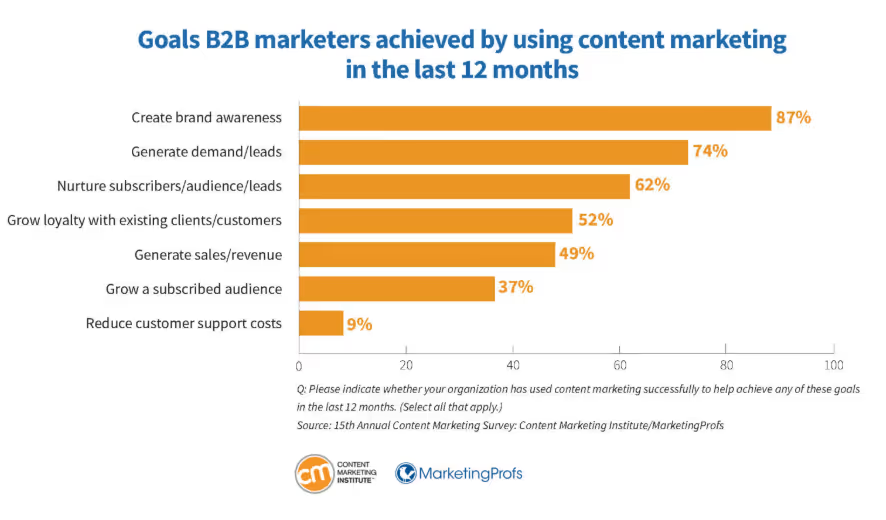
So, in this blog, we’ll break down the entire process of how to write B2B content that doesn't just rank but drives results with the top 10 content formats you can use in B2B.
The Blueprint for Creating Content That Converts
When we first started creating content, we were also stuck. We didn’t know why our really good blogs didnt rank. And after some digging, we realized, we have been churning out content that everyone knows.
So, we changed our process so that our content is strategically structured, deeply researched, and optimized to guide the buyer from search to action.
Last quarter, every blog we published ranked. Here's the step-by-step content process that made it happen.
Step 1: Craft a Comprehensive Outline Based on Top-Ranking Blogs
Before you start with B2B content writing, the first step is to create a strategic outline. A strong outline eliminates guesswork for the writer, saving time, reducing rewrites, and turning a blank page into a clear, confident draft.
1. Research Top-Ranking Blogs
The first thing we do at Revv Growth is analyze the top-ranking content for our target keywords. Here's what we look for:
- Content Structure: Identify how the best-performing blogs organize their content. What headings do they use? How do they guide the reader from one point to the next?
- Depth of Information: Does the blog go deep into the topic or just skim the surface? We aim to go deeper and deliver more value.
- Content Gaps: Are there important details or subtopics missing from the content? These are the areas we focus on to differentiate and improve.
2. Build a Detailed Outline
Once we’ve completed SERP research, we turn those insights into a detailed outline not just to organize the content but to position it strategically to outrank competitors and guide the reader from search to solution.
And that’s the same process we follow for our client’s blogs too.
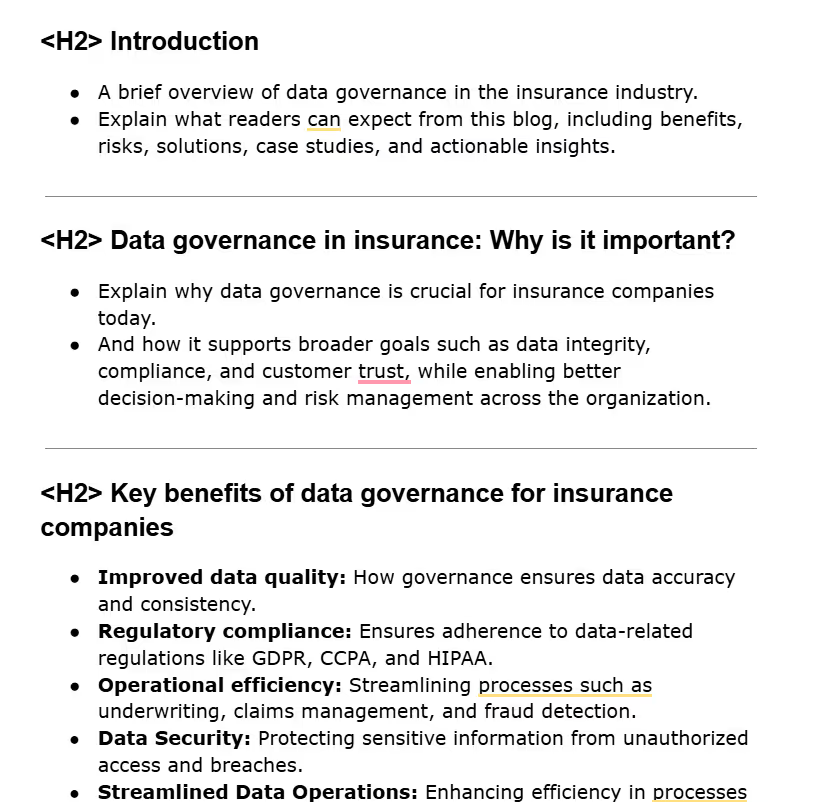
- Clear Headings and Subheadings
We structured the content with both SEO and user experience in mind. Every H2 is crafted to align with exact search intent, while the outline uses intuitive subheadings and relevant keywords, making the blog easy to skim, yet packed with in-depth insights across 2,000+ words.
- Every Key Angle Is Covered
We make sure our outlines cover every critical angle. For example, when writing a blog on data governance in insurance for a competitor, we noticed most ranking blogs focused only on compliance and regulation. We broadened the scope to include business impact, key evaluation criteria for governance platforms, and operational benefits, making the outline far more comprehensive and aligned with the reader’s intent. - Content Gaps Are Filled
During the outlining phase, we identified key content gaps through SERP analysis, including the lack of coverage around how modern governance platforms support AI/ML, security, and scalability. We intentionally added sections to address these gaps, backed them with real-world examples, and included a dedicated slot for the CSE Insurance case study to bring credibility and context to the final blog.
This structured outline didn’t just help us write faster, it ensured the final content was aligned with what buyers were searching for and what competitors missed.
3. Cover All Buyer Stages
We also ensure that the outline addresses different stages of the buyer's journey. This includes:
- Aligning sections with awareness, consideration, or decision intent.
- Adding actionable insights throughout to help readers move closer to making a decision.
Our Top 10 ABM Agencies for SaaS blog outline was created with this method. We noticed that competitor lists were generic and lacked decision criteria. So, we created a outline addressed that.
As a result, the blog began appearing in AI Overviews across platforms like ChatGPT, Copilot, Deepseek, and Perplexity.
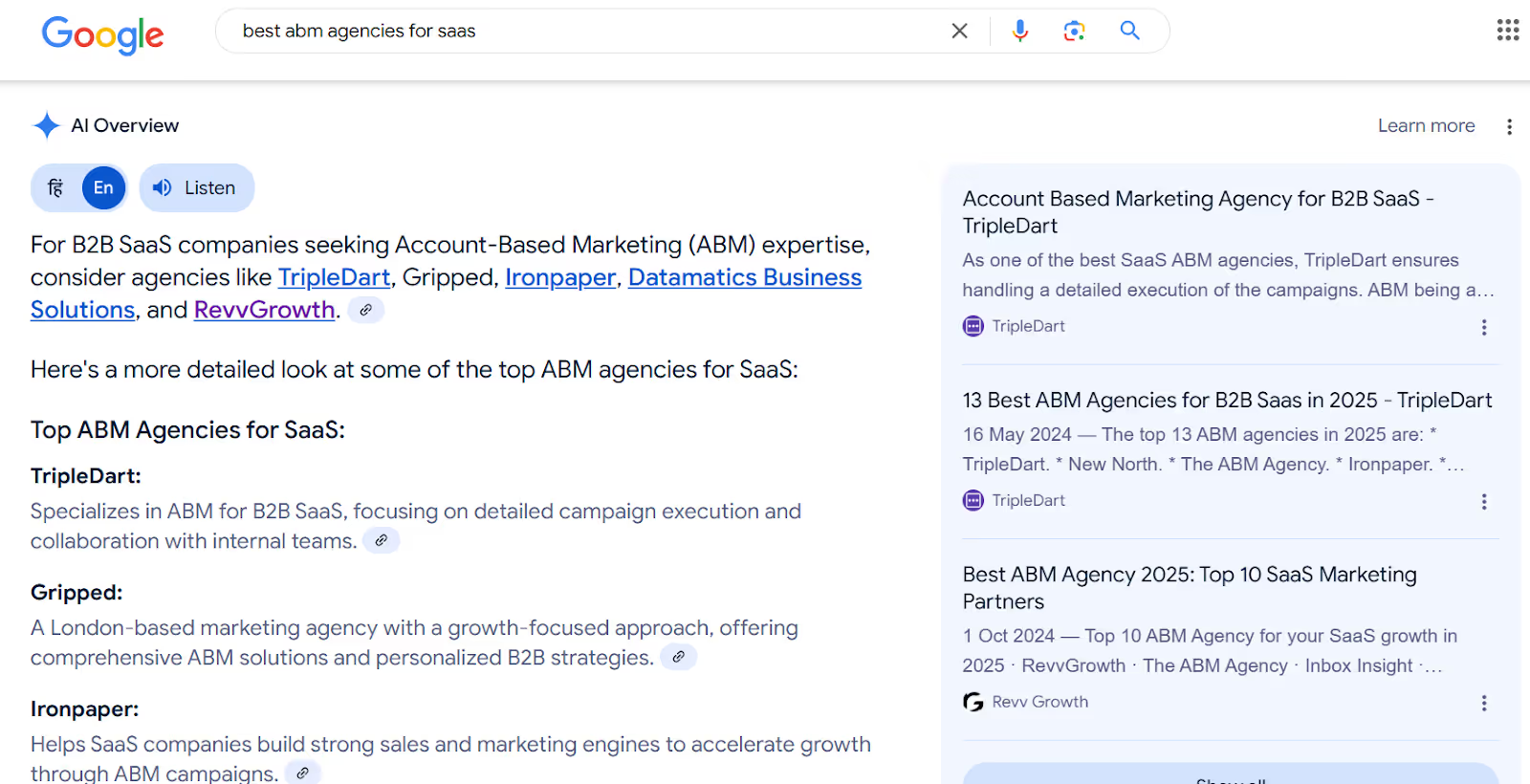
Step 2: Dive Deep into Research
We believe doing good research is the basis of every good content. In fact, it is so important, that we have a process doc just for it.
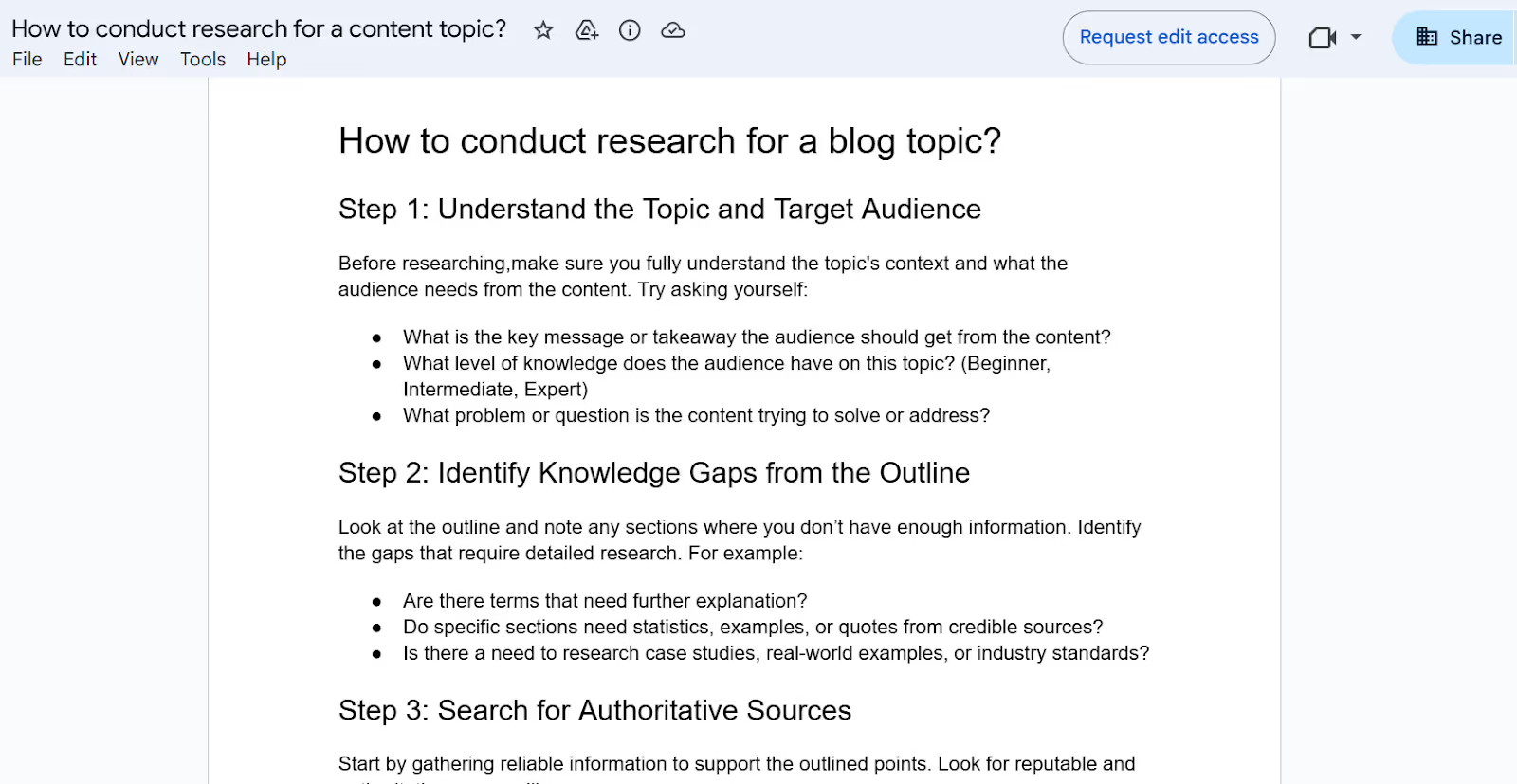
This doc walks the writer through how to approach any topic, from identifying audience knowledge levels to gathering quotes, sourcing stats, finding competitor gaps, and citing credible sources.
1. Find Credible Sources
We don’t rely on basic or outdated information. Instead, we look for:
- Industry Reports: These provide market-level insights. E.g., CMI, HubSpot, Forrester, and Gartner for market trends.
- Surveys and Case Studies: Real-world data and examples help back up our claims. Browse platforms like Statista, G2, and Marketing Charts.
- Expert Quotes: Where possible, we include comments from subject matter experts to build authority and trust. Try Featured & Qwoted for SME quotes.
2. Use Alternative and Hidden Sources
We go beyond traditional research methods:
- Explore Reddit threads, Quora discussions, and Medium posts to understand how real users talk about the topic. While writing our Best ABM Tools blog, we noticed that most blogs listed tools without showing how real marketers use them. So we explored Reddit threads where B2B marketers discussed what they liked (or hated) about ABM platforms like 6sense, Demandbase, and Clearbit, and linked them in our blog.
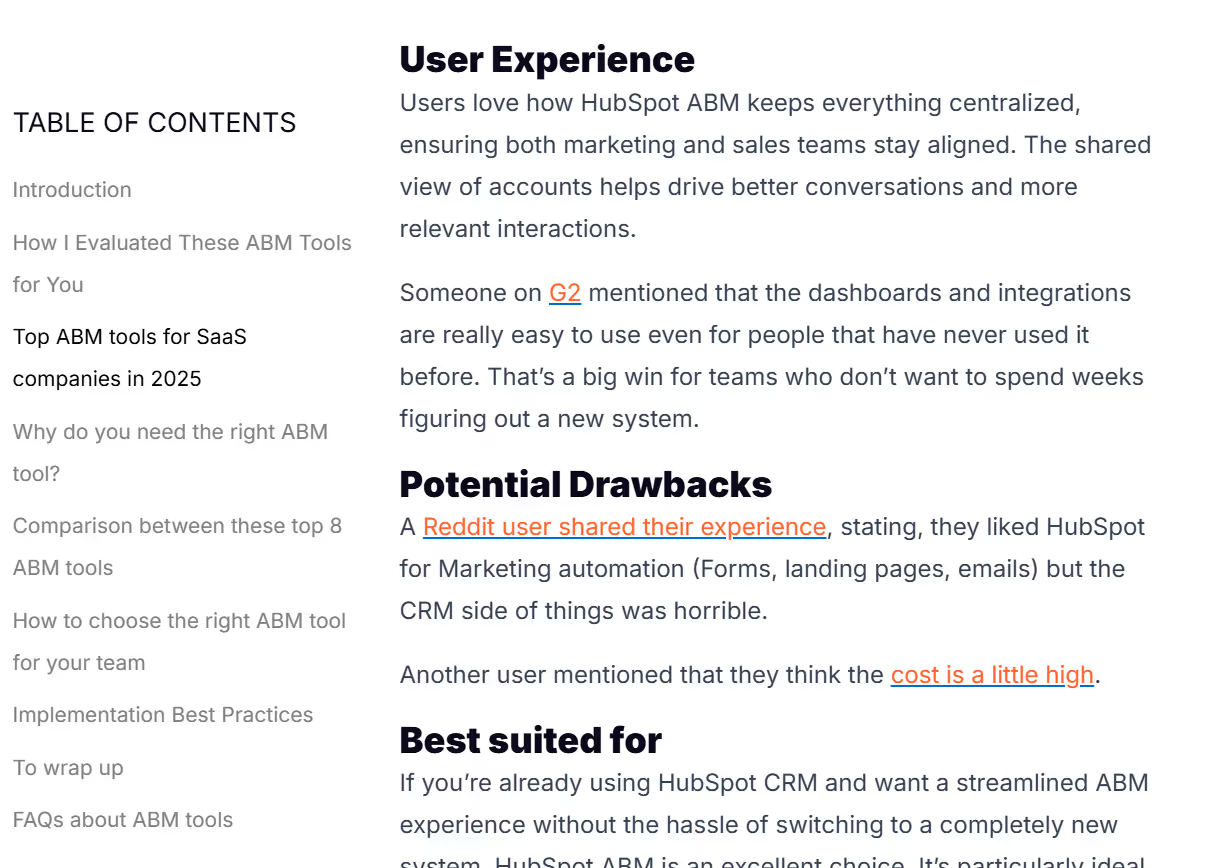
The blog now ranks on Page 1 for high-intent terms like “top ABM tools for SaaS” and is regularly picked up in AI Overviews.
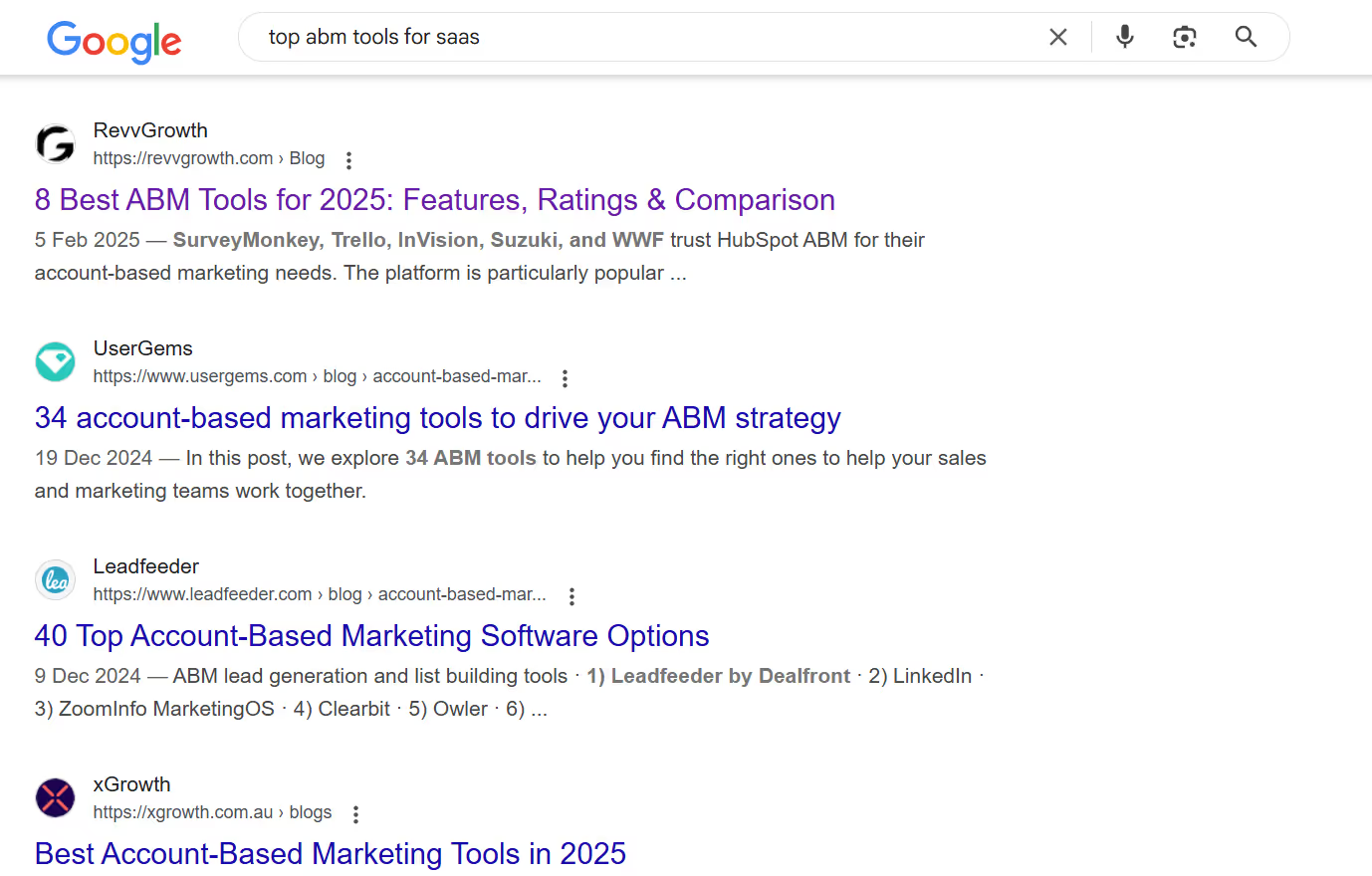
- Reach out to industry professionals or customers directly to collect fresh, first-hand perspectives. At Revv Growth, we often reach out to founders, GTM leaders, sales managers, and RevOps heads to gather fresh, first-hand perspectives that add depth and credibility to our content. While writing a blog on Top SaaS Content Marketing Tools, we wanted authentic input on Clay.ai. So we reached out to our Lead data analyst and asked for his favorite features, pain points, and even requested dashboard screenshots. He replied with exactly what we needed, which we can include in the blog as a mini use case.
These kinds of organic insights make the content feel real, not recycled, and they’re often the differentiator that helps our blogs rank, resonate, and get picked up by AI Overviews.
- Monitor LinkedIn comment sections or join Slack communities like Superpath, RevGenius, or ExitFive. And most importantly, our own Revv Growth community, where marketers, sales leaders, and RevOps professionals actively share challenges, frameworks, and wins.
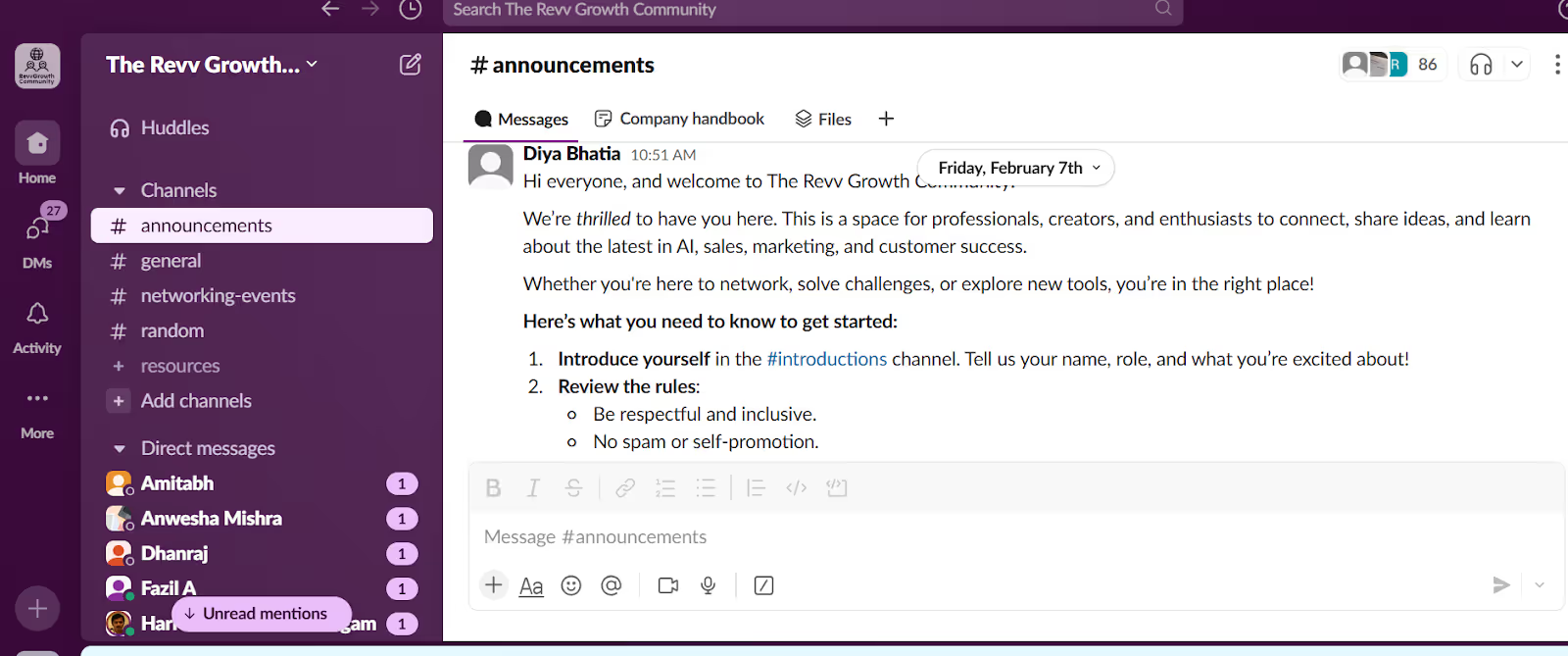
We use it to:
- Ask open-ended questions to validate content angles
- Source contributor quotes and pain points directly from the field
- Stay ahead of what’s top of mind for practitioners across SaaS, ABM, and growth
These communities often reveal more than any keyword tool because they show you what real practitioners are asking before it trends on Google.
So when we see recurring questions around ABM measurement or content ROI in our community, we turn those into blogs, teardown threads, or newsletter features, meeting the market exactly where it is.
3. Organize Your Research
Before we write a single word, we organize everything in one place so the writing process becomes faster, smoother, and more strategic.
- We centralize everything in a shared Google Sheet that includes keywords, references, search intent, funnel stage, internal link targets, and a link to the outline doc.
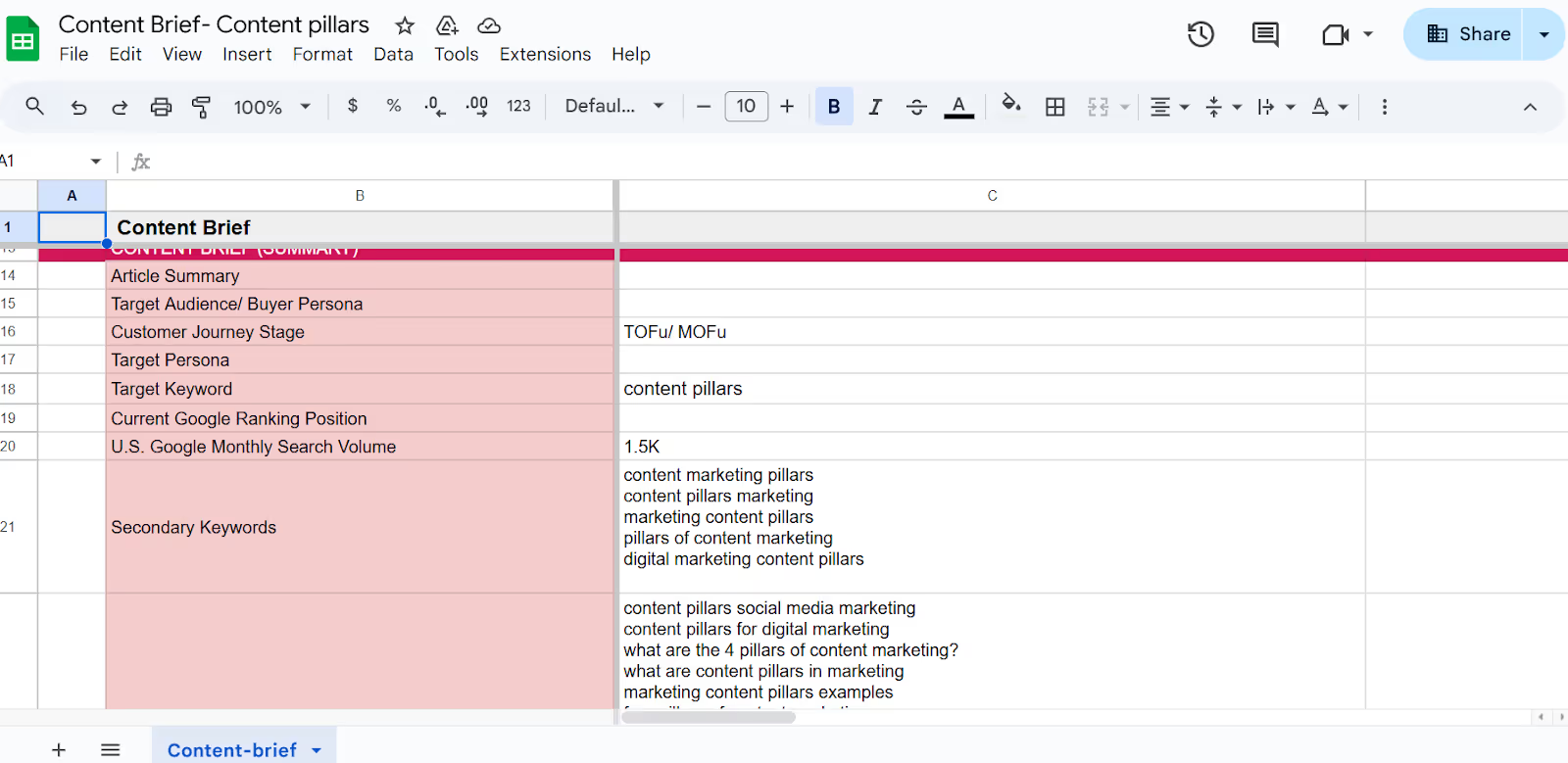
- We build detailed outlines in Google Docs using H1, H2, and H3 structures. Each section is mapped to a specific buyer stage and includes notes on messaging and CTA alignment.
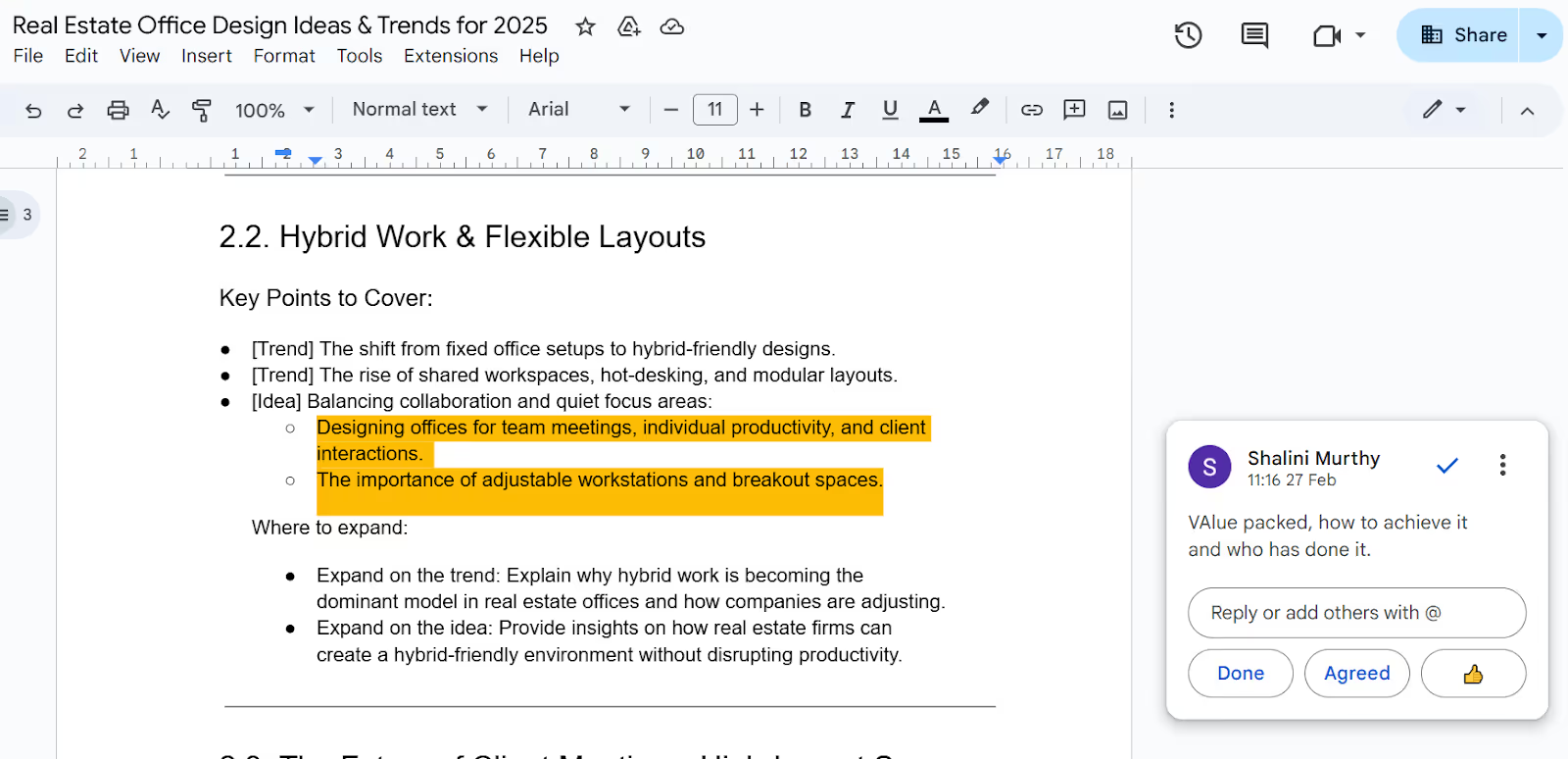
- We maintain a separate Google Doc as a swipe file with tabs for stats, expert quotes, examples, and image references, all linked to their relevant sources. This file grows with every project, helping us pull trusted, pre-vetted material for new blogs without starting from scratch.
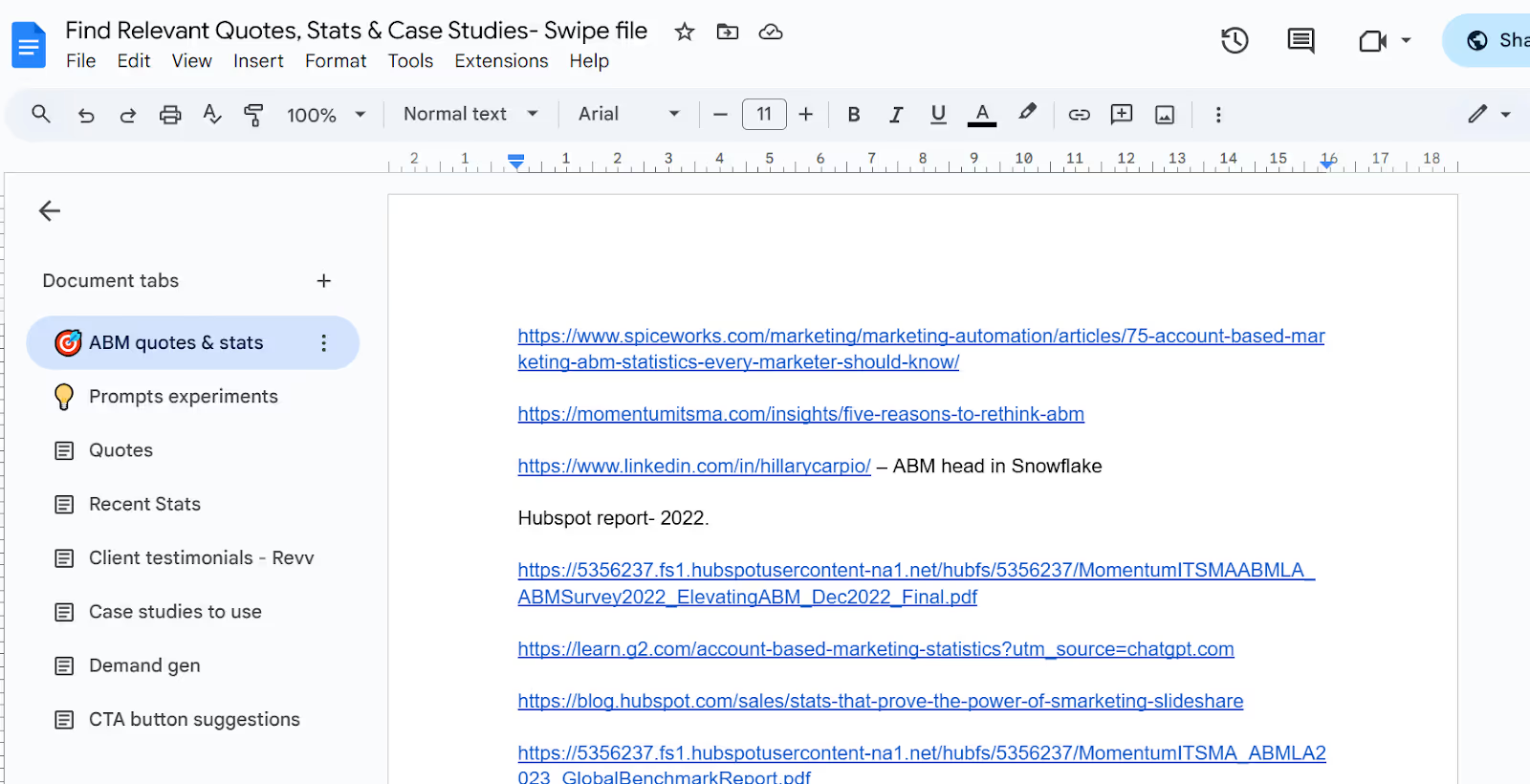
This prep work might take an extra 30–45 minutes up front, but it saves hours during writing, editing, and optimization, and it’s a key reason our content consistently ranks, resonates, and drives pipeline.
Step 3: Write the First Draft (Don’t Worry About Perfection)
Once the research and outline are in place, we move into writing, but we don’t aim for perfection on the first go. The goal is to get ideas down fast while the strategy is still fresh.
At this stage, it’s not about polished sentences. It’s about turning a structured outline into a rough but complete draft that captures your thinking and supports the buyer’s journey.
1. Focus on Getting Ideas Down
We write fast and lean into the structure we’ve already built. The goal is to translate strategy into the story.
- We follow the H1–H3 structure from the outline without second-guessing the flow
- We pull in quotes, stats, and examples from our swipe file as we write
- We just get the ideas on the page and create a rough draft.
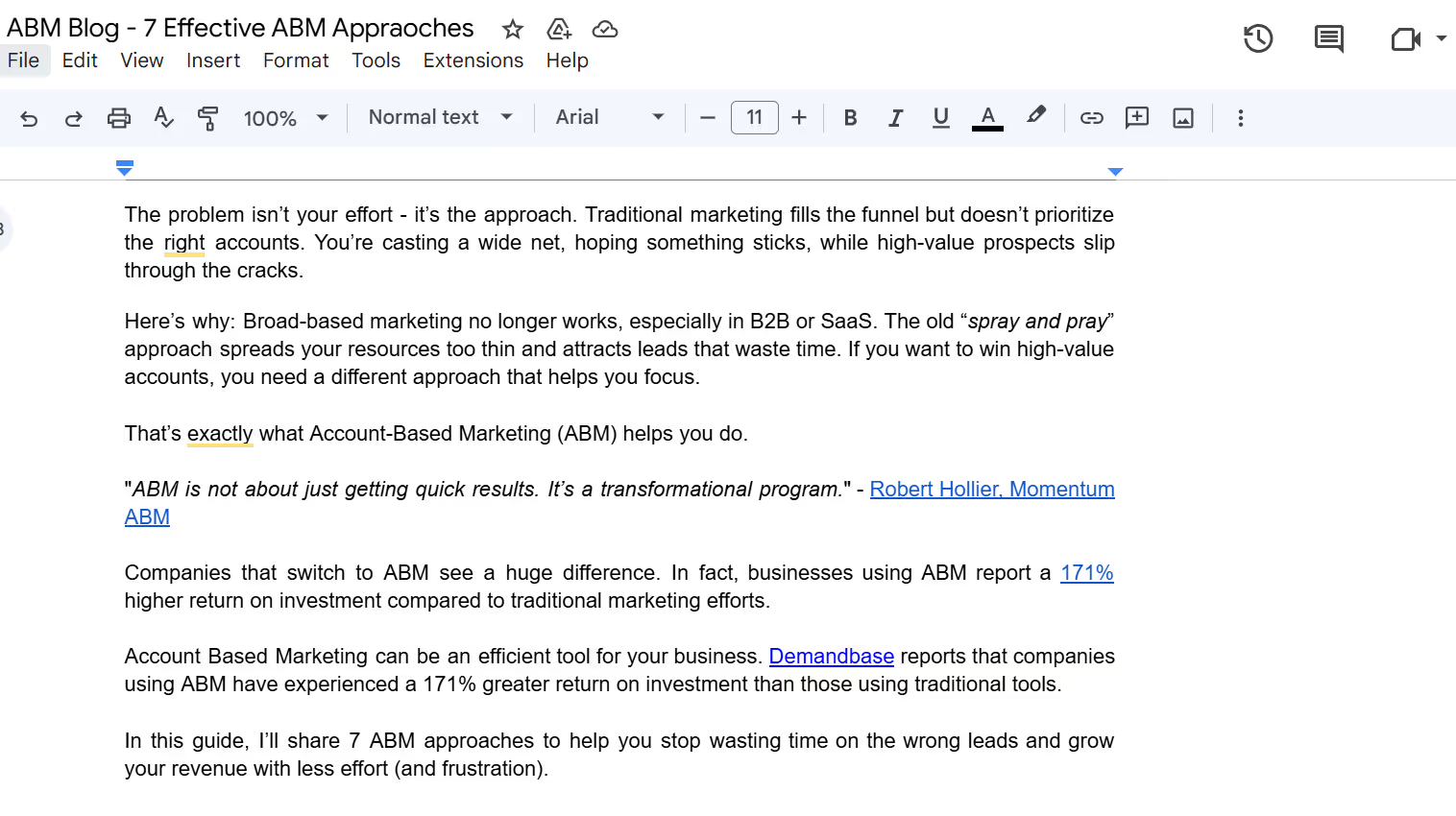
This keeps the writing process smooth, avoids creative blocks, and makes sure the narrative doesn’t drift off-track.
2. Use AI to Enhance, Not Replace
We use AI tools as a support layer, not a shortcut.
Here’s how we use it strategically:
- SEO Optimization: Tools like Clearscope, Surfer, and Frase.io help us confirm keyword coverage and suggest semantic terms to include naturally. For example, when writing a blog for our client Flipspaces on “Real Estate Office Design Ideas”, we used Frase to identify additional search terms like “modern office layout,” “workspace trends,” and “employee wellness design” that competitors were missing, helping us enhance search depth and relevance.
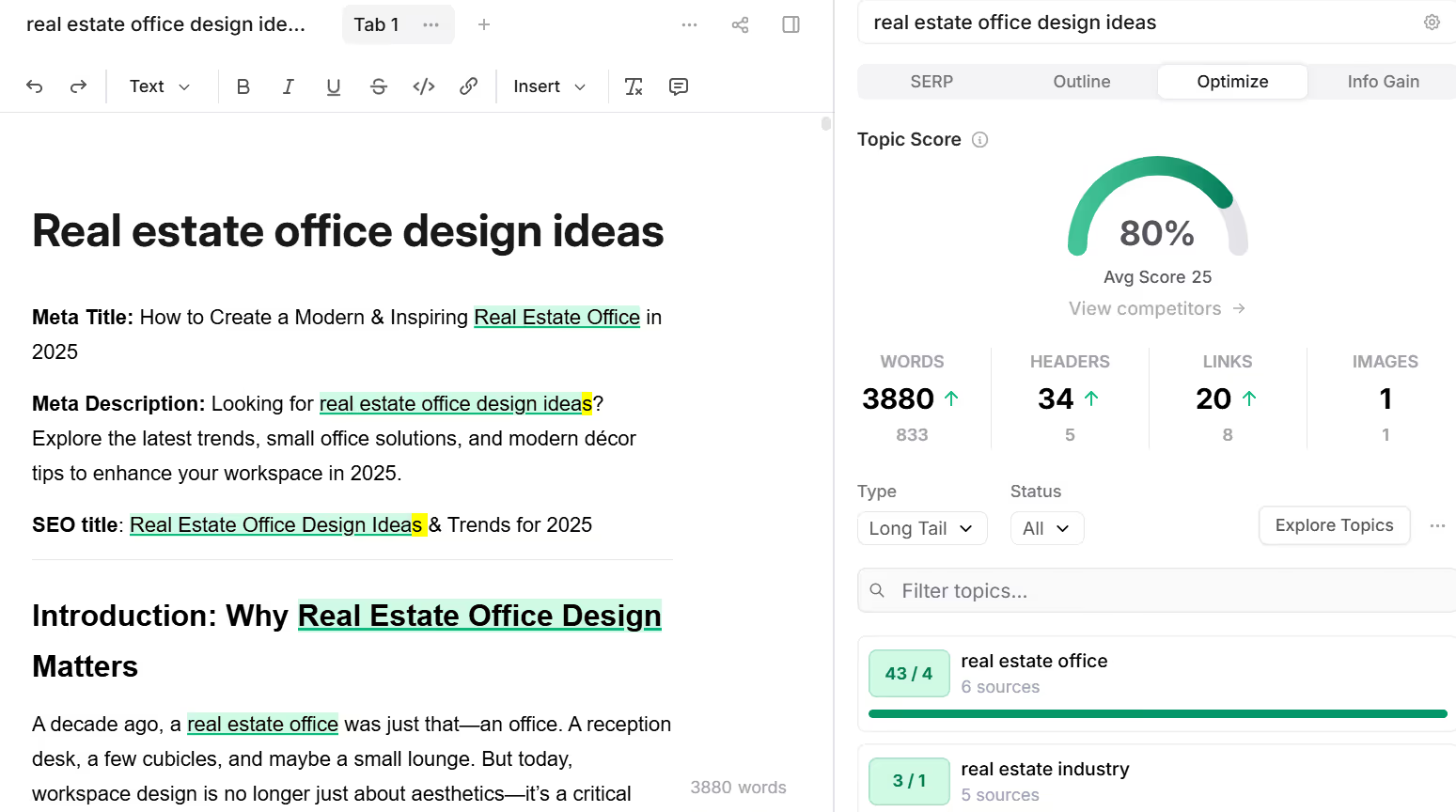
- Language Improvement: Grammarly AI or ChatGPT helps tighten sentence flow, adjust tone, and ensure readability, especially in longer sections. In the same Flipspaces blog, we used Grammarly to refine interior design jargon into simpler language suited for business readers and used ChatGPT to reframe a dense paragraph on “ergonomic layout planning” into something skimmable and clear without diluting the insight.
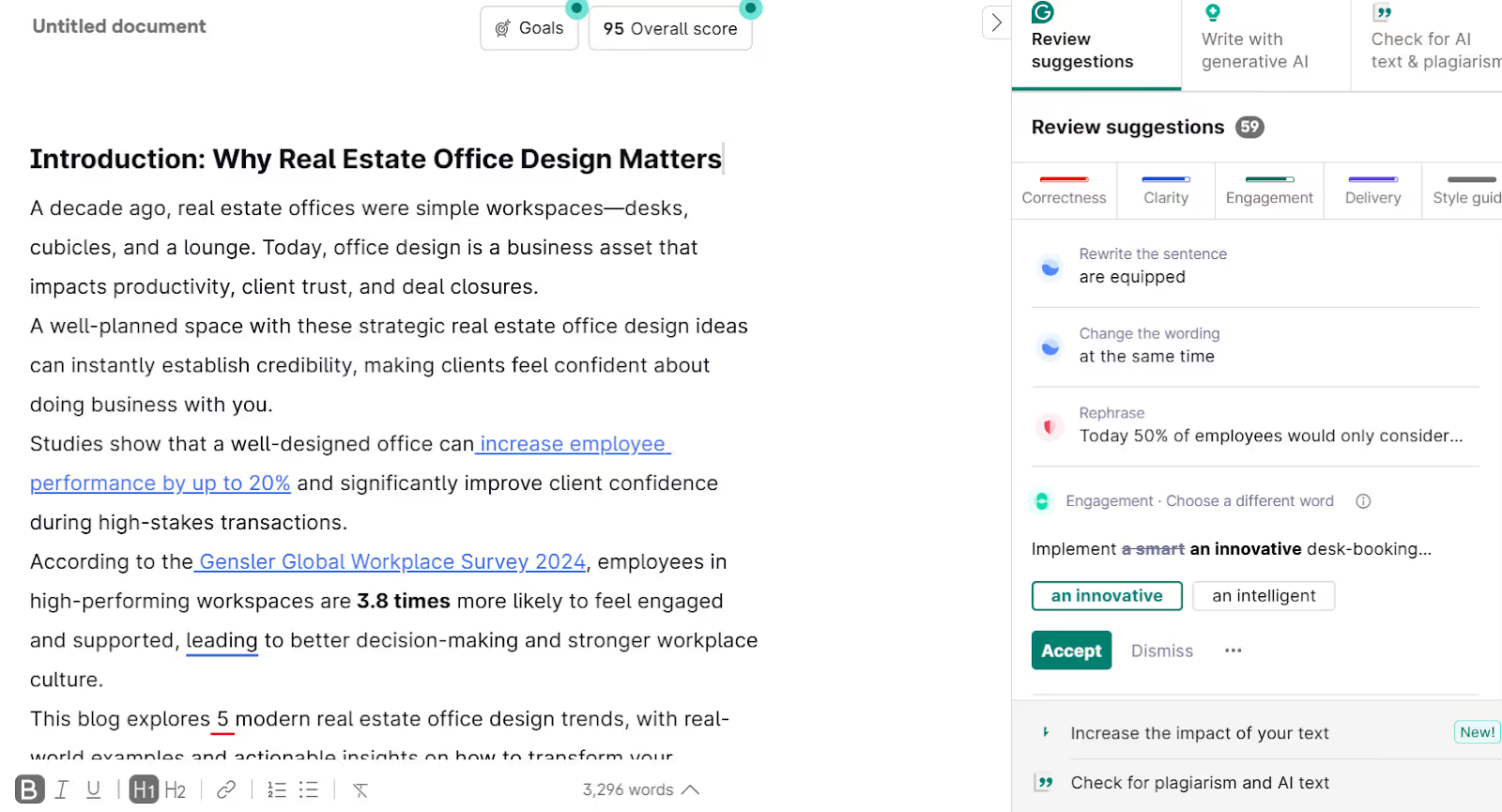
- Content Enrichment: We sometimes ask AI to suggest FAQs, analogies, or examples that could make the section stronger (then we fact-check and customize). We’ll ask, “What questions would someone ask about office design trends?” and use those suggestions to build or enhance sections, always verifying and customizing before publishing.
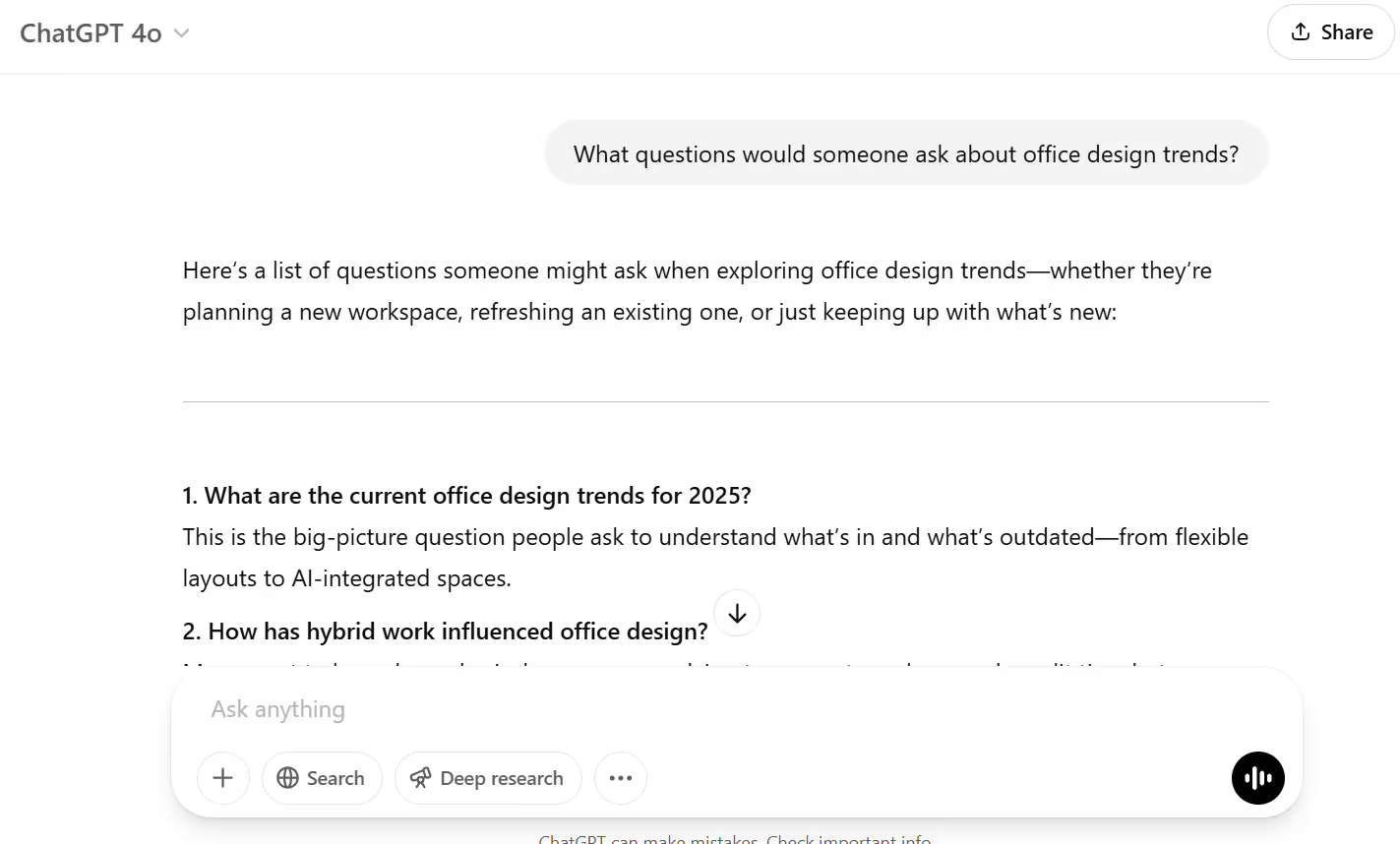
But the thinking? That still comes from us. We don’t copy-paste AI output, we use it to refine and accelerate what’s already grounded in strategy and research.
Step 4: Polishing the Draft
Once the first draft is complete, we shift into the editorial phase, where the content moves from raw ideas to a refined, conversion-ready asset. This is where structure, tone, and clarity get dialed in to meet our internal quality benchmarks.
1. Self-Editorial Checklist
Before a draft moves to review, our writers ensure it is:
- SEO-optimized: Are keywords naturally placed? Are meta descriptions drafted? Are headings aligned with search intent?
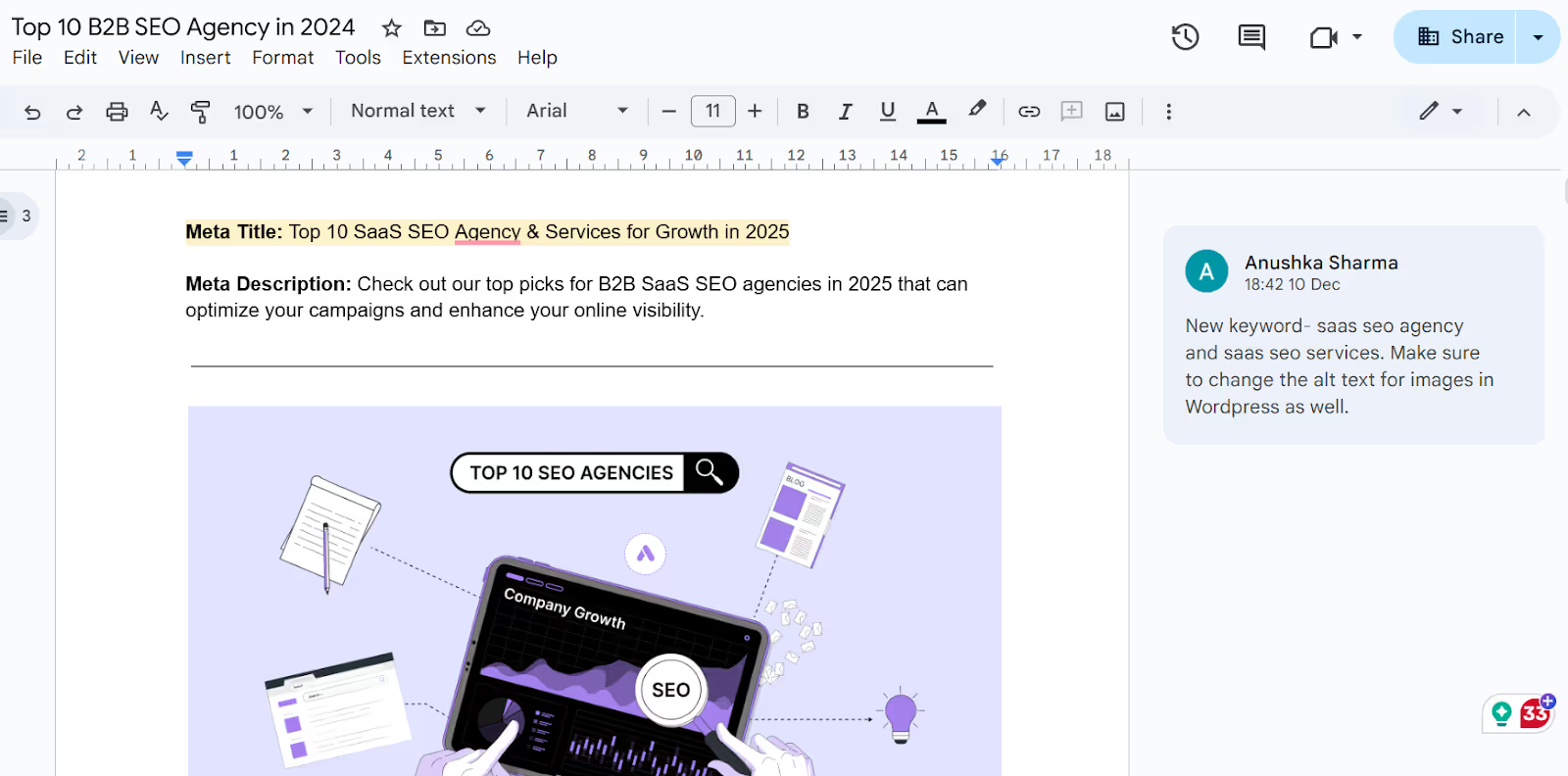
- Clear and Concise: Is the content tight, fluff-free, and easy to understand?
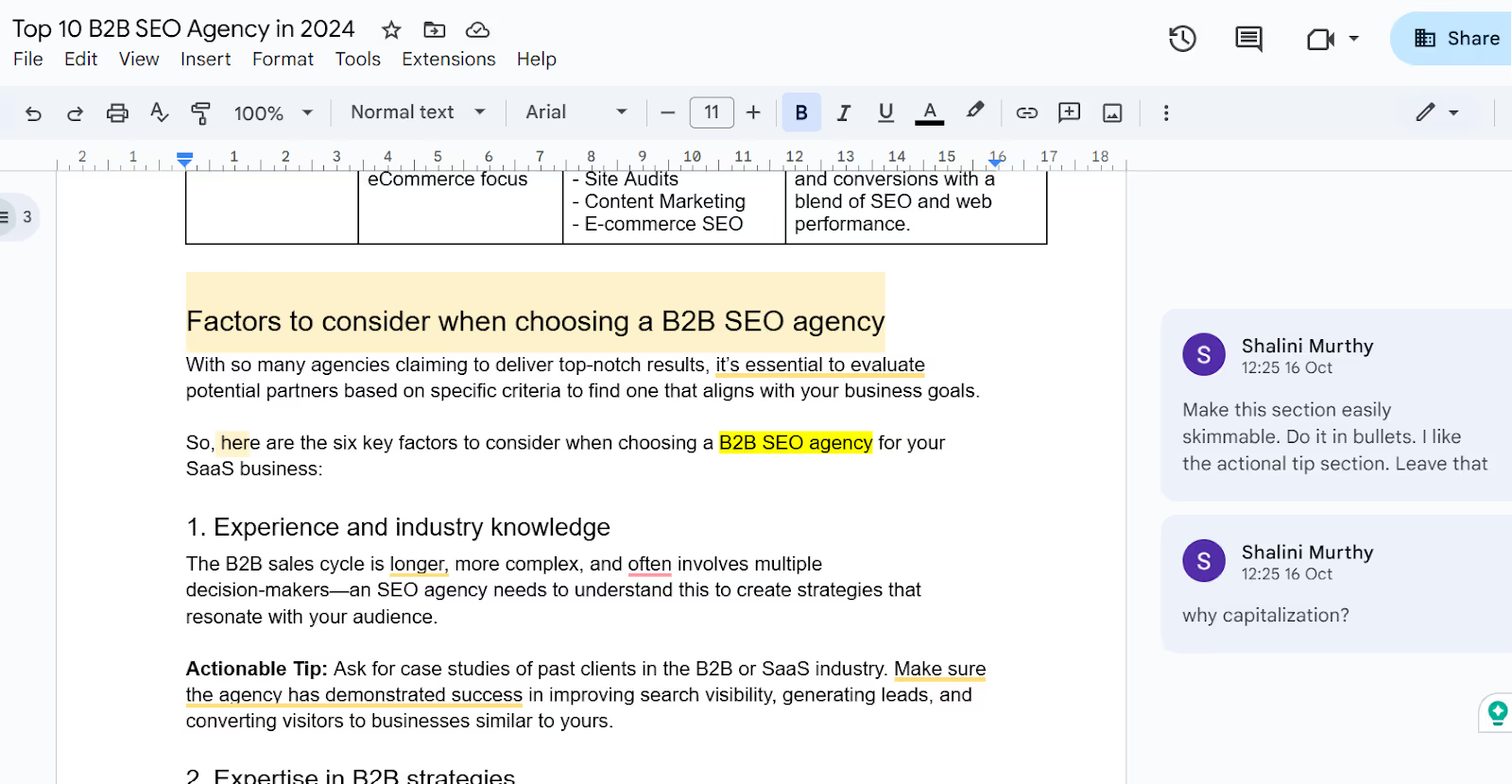
- Engaging: Does the tone match the audience? Is it easy and enjoyable to read? We write with the reader in mind, avoiding jargon, keeping the tone conversational, and making even strategic concepts feel actionable.
In our blog on SaaS Content Marketing Pillars, we took a complex topic, building content pillars, and turned it into an easy-to-digest guide.
Instead of just explaining what pillars are, we showed how to build them, mapped them to funnel stages, and included real brand examples across SaaS categories.
That made the content not just educational but relatable and practical, especially for founders and marketing leads trying to turn vague strategy into an actual roadmap.
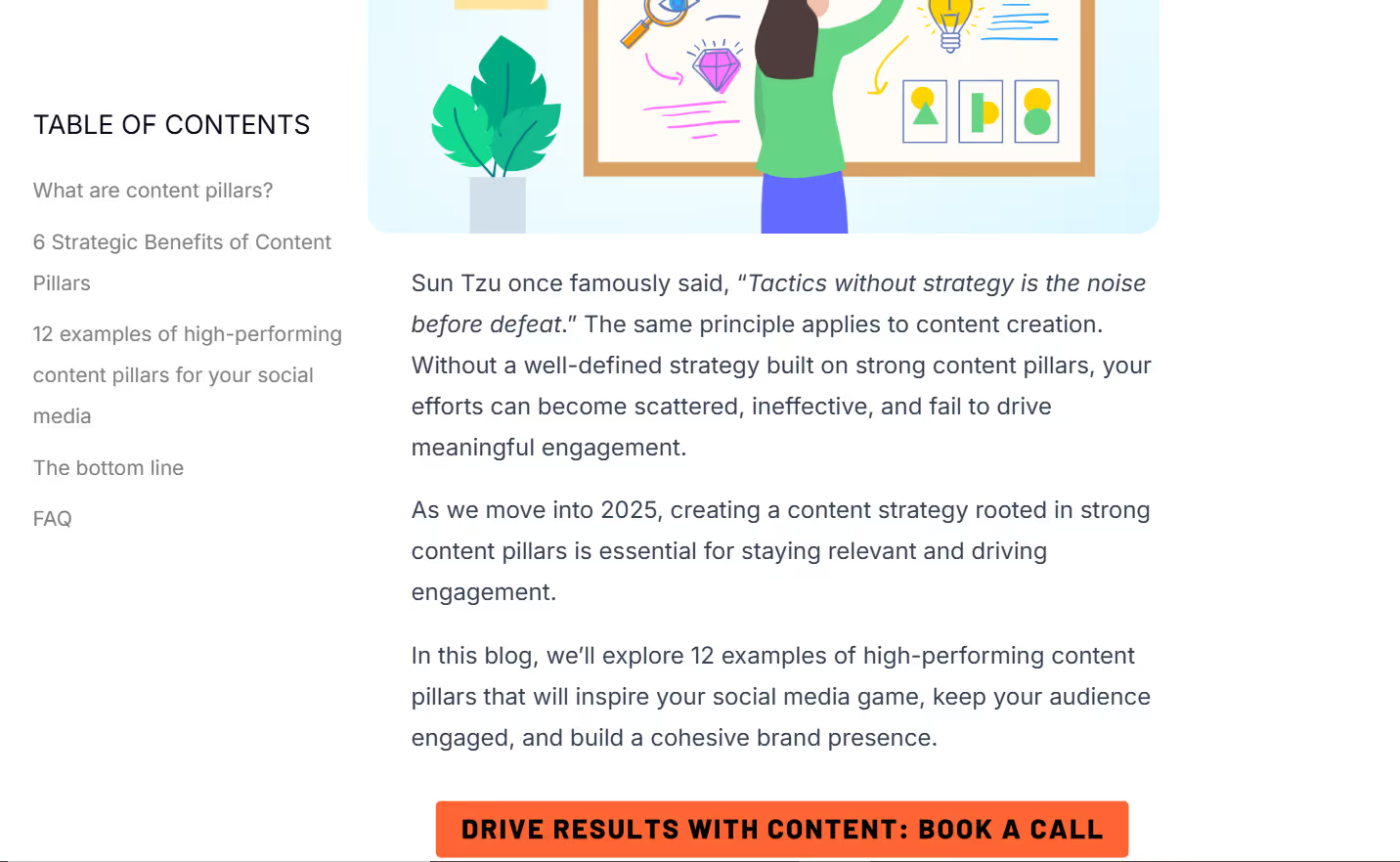
This checklist keeps our drafts strategic and self-contained, reducing friction during the edit.
2. Content Head’s Editing
Once self-editing is complete, the content head reviews the draft to:
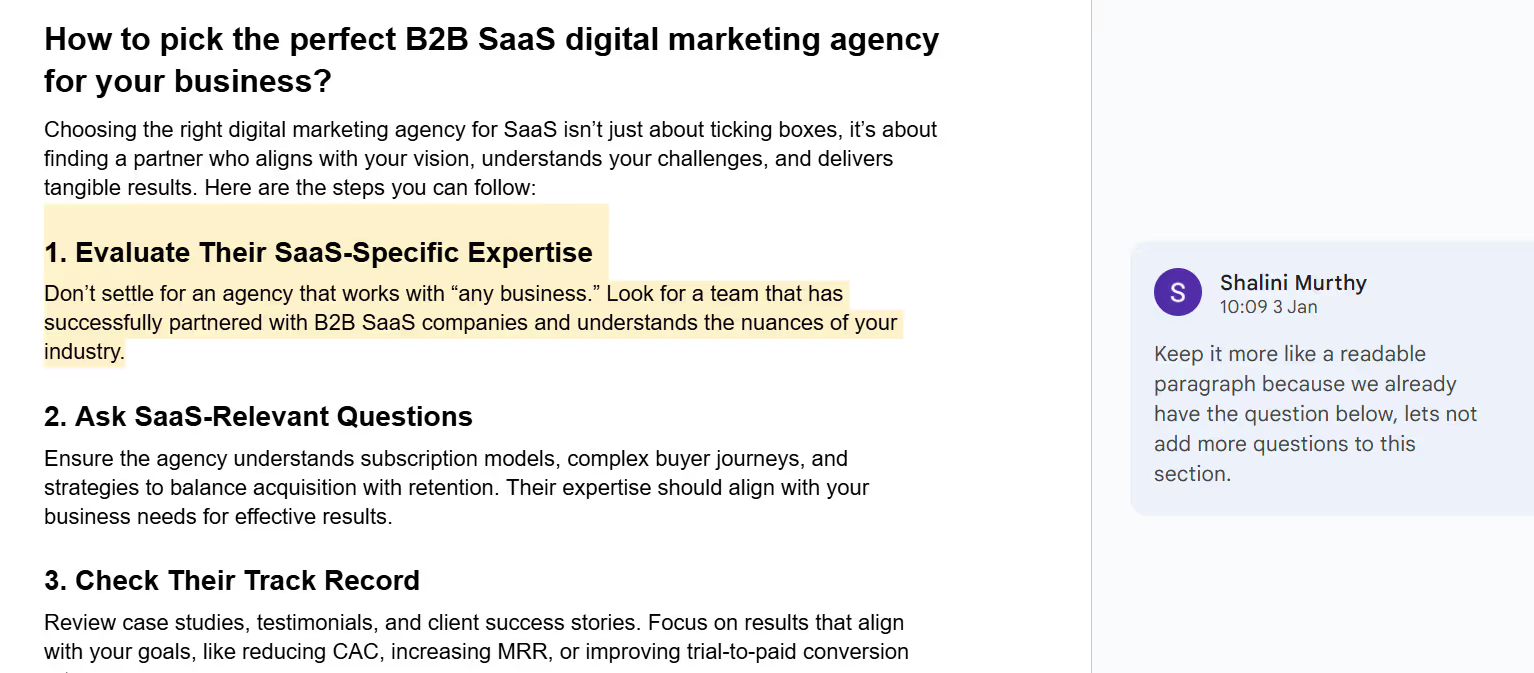
- Tighten the language further and make sure it’s as clear as possible.
- Ensure the flow is seamless and the story makes sense from start to finish.
- Confirm that the content aligns with the brand’s tone and voice.
3. Feedback Loop
After editing, the draft is returned to the writer for any revisions. Once changes are made, the content is reviewed again. This back-and-forth continues until the content is final and meets our internal quality standards.
Step 5: Final SEO and Readability Checks
Before we publish, we use Yoast SEO to perform a final round of checks to ensure the content is both optimized for search and enjoyable to read.
1. Final SEO Review
Every blog goes through a technical and strategic SEO review before publishing. Here’s what we check:
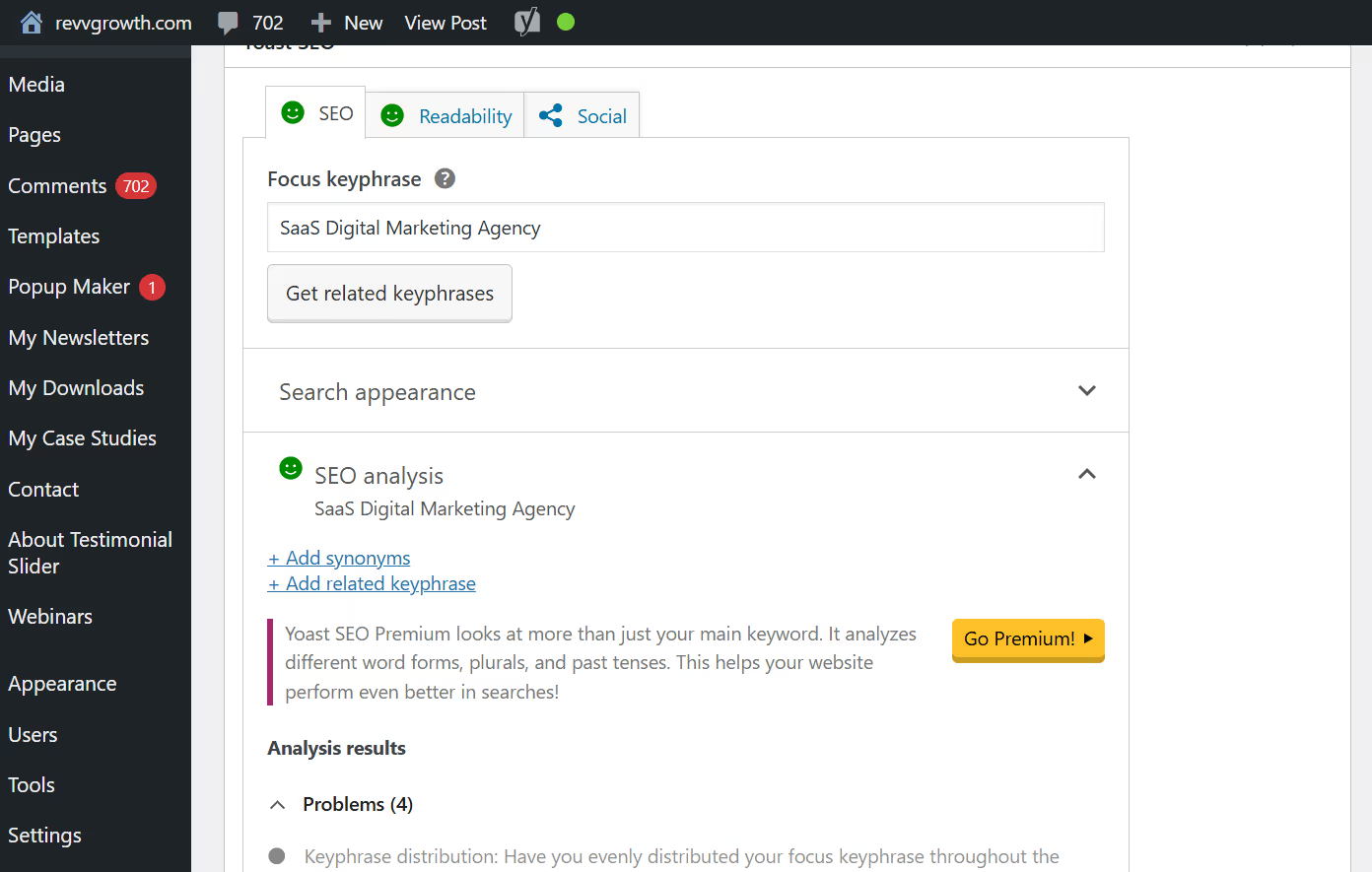
- Strategic Keyword Placement: Keywords are naturally used in headers and body copy. In our SaaS Digital Marketing Agencies blog, for example, we used the phrase “SaaS digital marketing agency” in the H1 and supporting subheads to align with how buyers search.
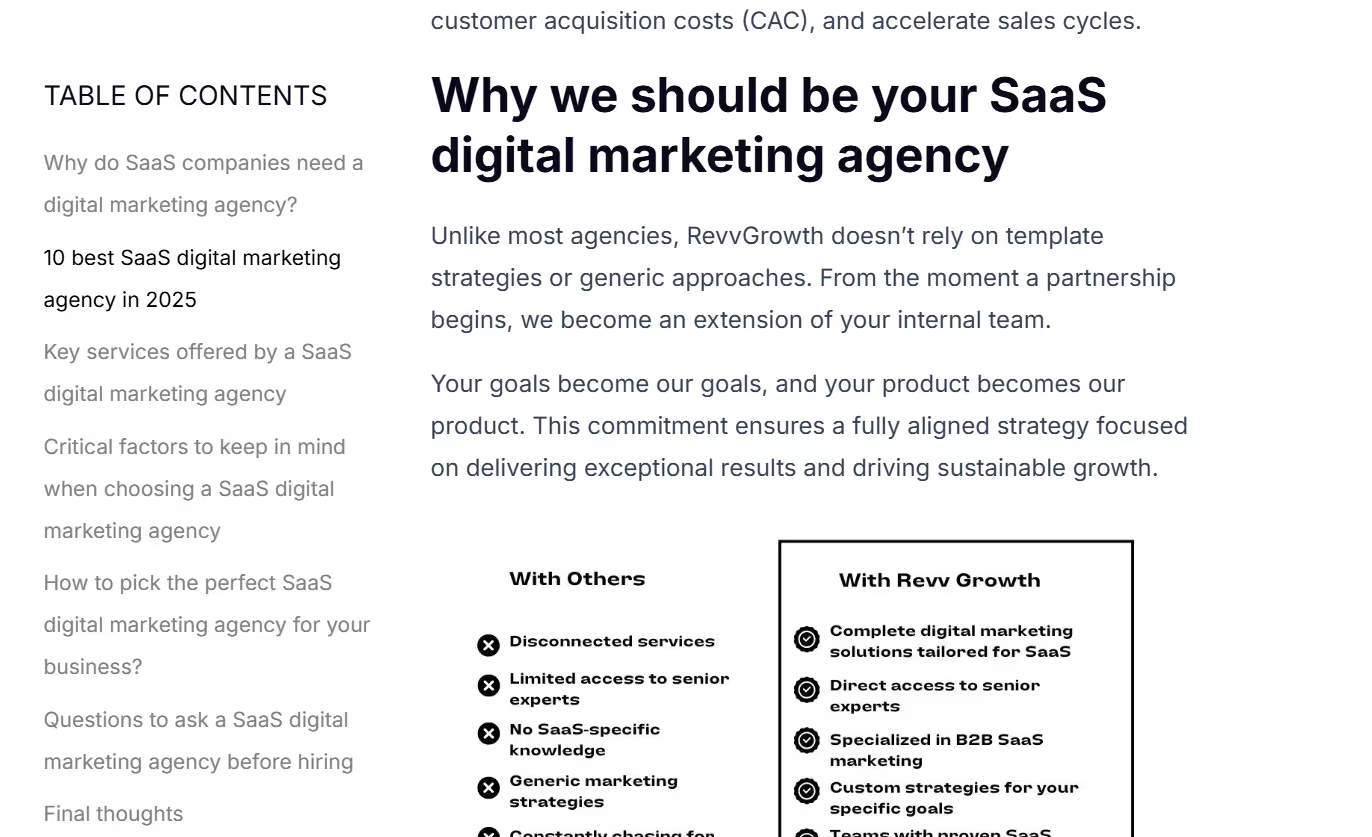
- Meta Descriptions: We write clear, enticing meta descriptions that reflect real search behavior. For this same blog, the meta line focuses on helping SaaS founders shortlist agencies based on strategy, expertise, and customer success

- Internal Links: Links to relevant blogs, case studies, service pages, and landing pages using UTM parameters to track content performance across campaigns.
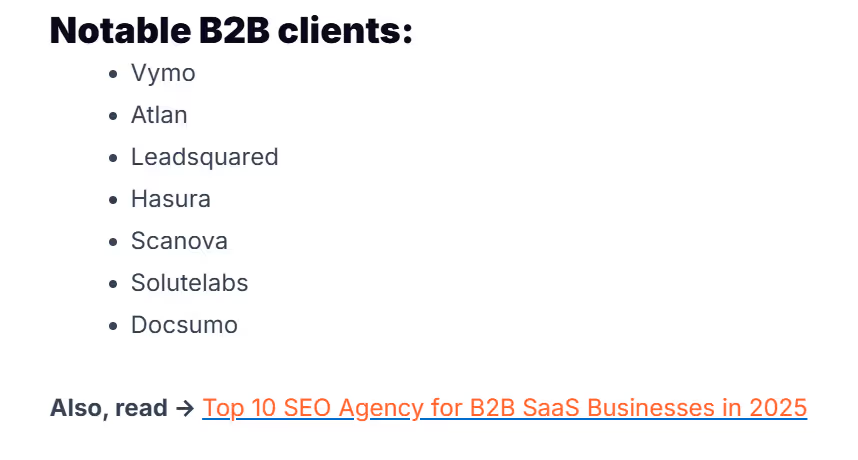
- Alt Text: All images are tagged with descriptive alt text that matches the topic (e.g., "comparison of SaaS agencies by expertise"), improving both accessibility and SEO relevance.
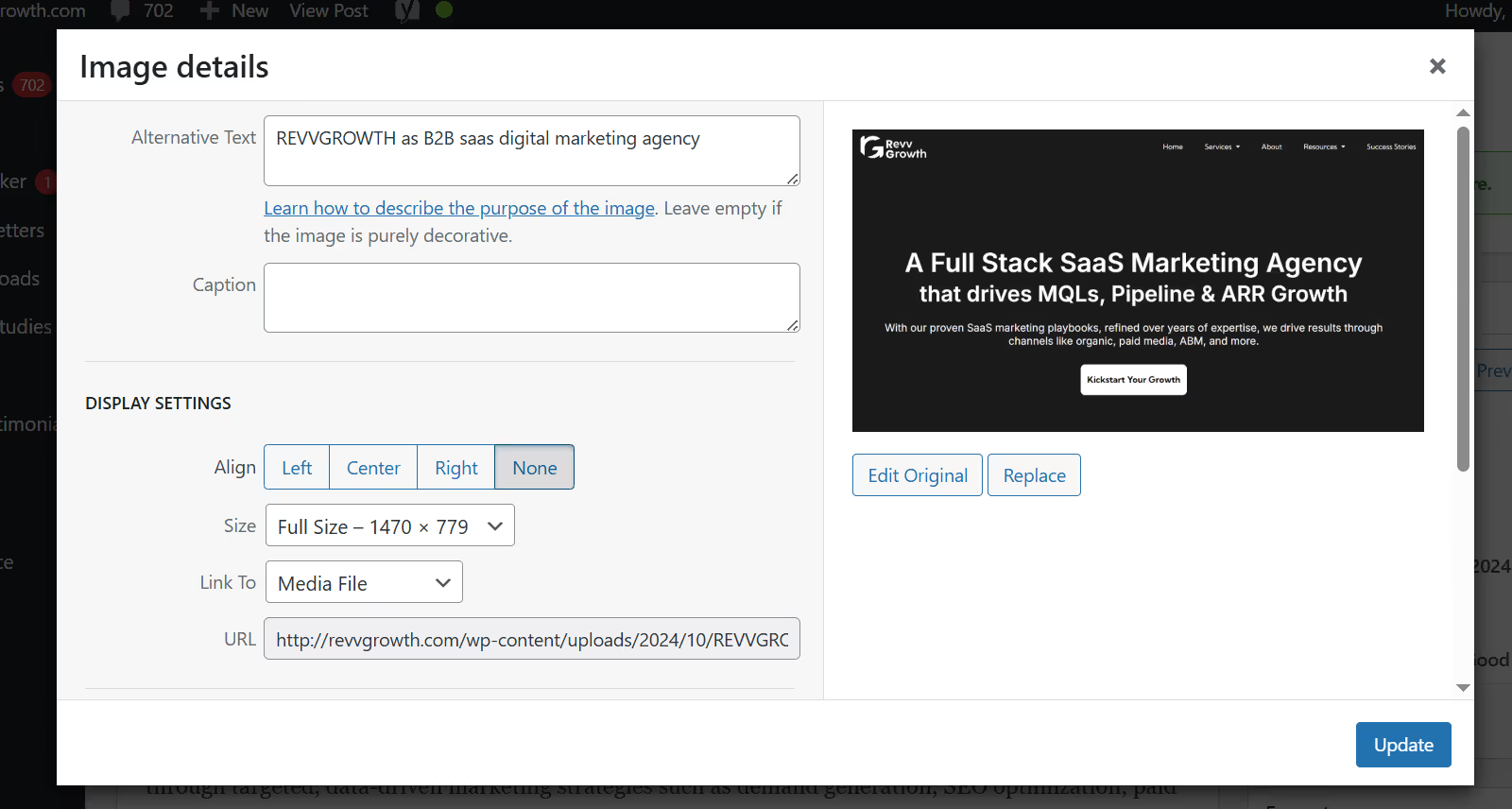
2. Readability Check
SEO gets you ranked. Readability keeps readers engaged. Here’s what we focus on:
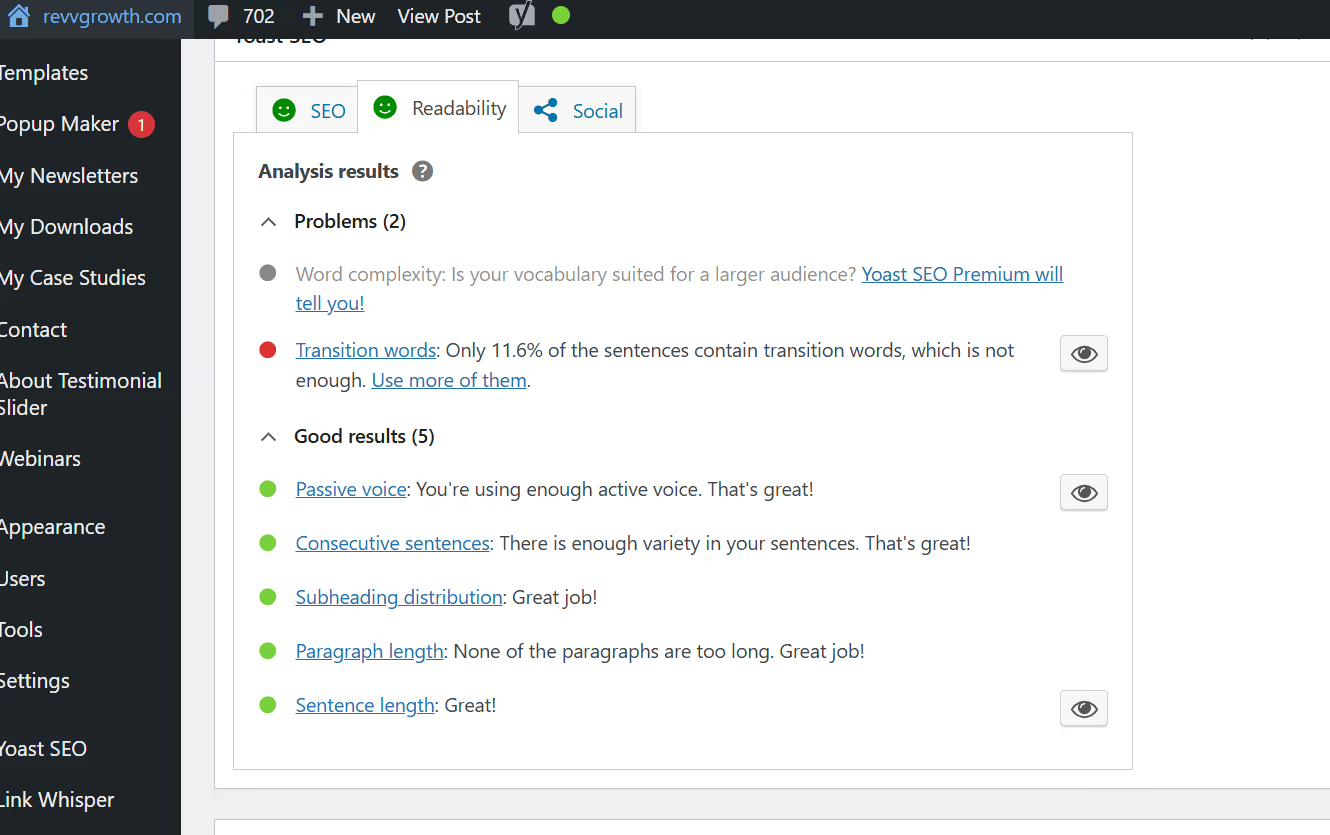
- Ease of Skimming: Use of short paragraphs, bullets, and subheadings. In the SaaS agencies blog, we formatted each agency review using consistent subheaders and bolded highlights to make it skimmable for busy founders.
- Clarity of Message: Each section clearly addresses one aspect of the decision journey, from how to choose the right agency to the pros and cons of each agency..
- Flow and Transitions: We ensure the narrative smoothly guides the reader from awareness (what makes a great SaaS agency) to decision (shortlisted options and CTAs).

By combining SEO precision with a clean, skimmable structure, we make sure every piece is built to rank and convert.
Step 6: Publish and Track Performance
Once the content is finalized, we don’t just hit "publish" and forget it; we track how it performs and optimize based on results.
1. Track SEO Performance
Every published blog is monitored using Google Search Console, GA4, and UTM tracking. We look at key indicators that reflect both visibility and buyer intent:
- Search Rankings: We track the rankings for primary and semantically related keywords to understand how well our content is positioned in SERPs.

- Organic Traffic & CTR: Using Google Search Console, we monitor impressions, clicks, and CTR to identify high-potential pages. If a page has high impressions but low clicks, we revisit meta titles and descriptions to improve relevance and entice more clicks.
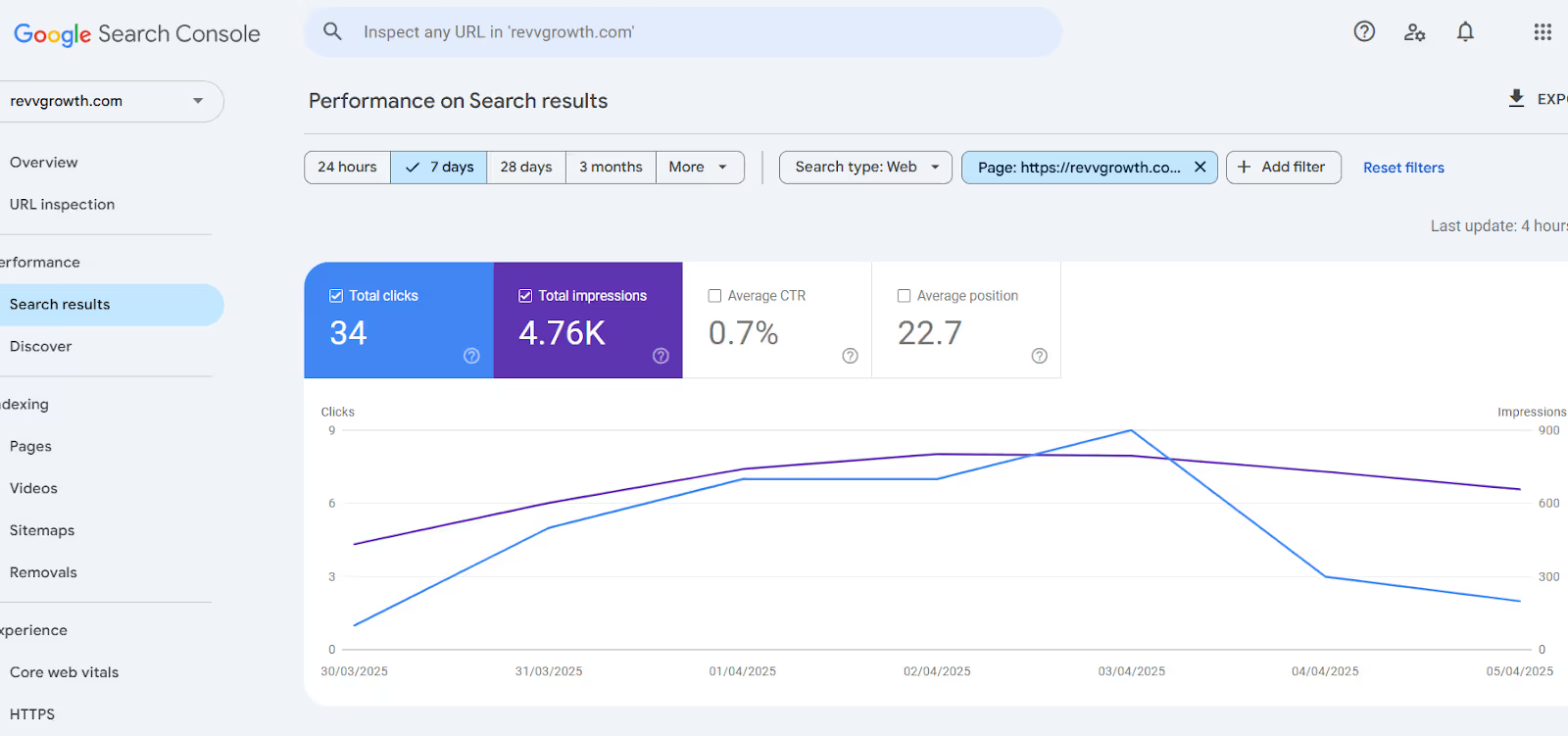
- Engagement Metrics like time on page, bounce rate, and scroll depth to see how deep readers go. These metrics help us understand how readers interact with the content, whether they’re skimming or reading deeply. This informs decisions like content length, structure, and internal linking.
- Assisted Conversions & UTM Clicks: For bottom-of-funnel blogs or pages with embedded CTAs, we track assisted conversions and UTM-tagged link performance. This shows us which pieces are influencing the pipeline and which ones need stronger calls to action.
These insights tell us what’s working, how readers are engaging, and where the next optimization opportunity lies.
2. Iterate Based on Performance
We treat every blog as a living asset. Every 30–60 days, we check in on performance and make adjustments:
- Update Stats & Data to keep the content current and trustworthy
- Reframe CTAs based on new campaigns, funnel shifts, or offer priorities
- Refresh Intros & Meta Descriptions to match changing search trends or better align with high-CTR phrasing
- Spin Off New Content from blogs that rank well, especially when we notice a section pulling its own traffic
After following this blueprint, your content won’t just check the “publish” box, it’ll be primed to perform. From strategy and structure to research and refinement, every step is built to drive impact, not just impressions.
Want to create B2B content that’s structured to win searches, support sales, and get picked up by AI? Book a call with our team at Revv Growth, we'll help you build a content strategy that turns structure into revenue.
Measuring B2B Content Performance: What Metrics Actually Matter?
"Great content marketing isn’t about content, it’s about the impact that content has on your business." , Joe Pulizzi, founder of the Content Marketing Institute
Most B2B teams track page views and traffic. But those numbers don’t tell you if your content is working. Here’s what actually matters in B2B content performance:
1. Conversion Rate
What it is: Measures how many visitors take a meaningful action, like signing up for a newsletter, booking a demo, or downloading a resource.
Nearly a third of marketing pros, 29% to be precise, cast their vote for conversion rate as an indicator of marketing success.
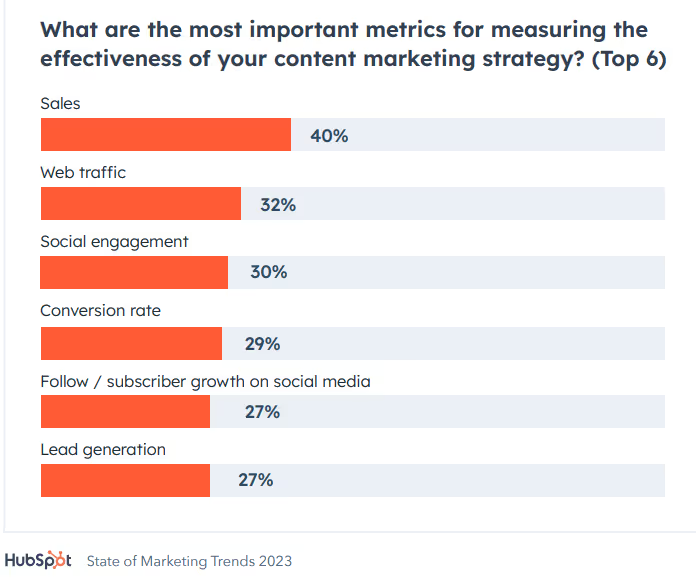
How to track it:
Set up custom events and goals in GA4 to track key actions like form submissions or button clicks. Use your CRM (e.g., HubSpot, Salesforce) to trace how content maps to lead stages. Check conversion paths to see which blogs assist conversions, even if they’re not the final touchpoint.
2. Pipeline Influence
What it is: Tracks how content contributes to qualified opportunities, revenue, or deal velocity.
“Content builds relationships. Relationships are built on trust. Trust drives revenue.”– Andrew Davis
How to track it:
Use multi-touch attribution models in your CRM or marketing automation platform. Set up lead scoring based on content interaction. Monitor which assets are mentioned in sales conversations, follow-up emails, or tagged in closed-won deals.
3. Engagement Time & Scroll Depth
What it is: Shows how long users stay on your content and how far they scroll, critical for understanding if people are actually reading.
69% of marketers use website engagement as a primary metric to measure content success, followed by conversions (67%) and website traffic (65%).
When readers stay, scroll, and interact, it’s a sign that your content is doing its job, delivering value, answering questions, and pulling them deeper into the funnel.
How to track it:
In GA4, use metrics like Average Engagement Time and Engaged Sessions per User. For scroll depth, enable scroll tracking in GA4 or GTM. Use Hotjar or Microsoft Clarity to generate heat maps and see where users lose interest.
4. Sales Enablement
What it is: Measures whether your content is being used by sales to influence decisions or close deals.
How to track it:
Build a shared content hub and monitor usage through CRM activity logs or enable tracking in tools like DocSend. Use feedback from your sales team to identify which one-pagers, guides, or blogs are referenced in conversations.
5. Content ROI: Is Your Content Worth the Investment?
What it is: Determines if your content is delivering more revenue than it costs to produce and distribute.
“When taking a content-first approach, our job as marketers is not to create more content … it’s to create the minimum amount of content with the maximum amount of results.” – Robert Rose, Content Marketing Expert
How to track it:
- Start by logging all content-related costs, including tools, freelancers, distribution, and internal team hours in a shared spreadsheet. Then, use your CRM (like HubSpot or Salesforce) to measure revenue influenced or attributed to each content asset.
- Apply this formula to calculate ROI: Content ROI = (Attributed Revenue – Content Cost) / Content Cost
- For a more accurate picture, combine this with UTM parameters, lead scoring, and assisted conversion tracking to understand how each piece contributes across the funnel, not just the last click.
Content becomes a growth engine when it delivers measurable outcomes. If your team is still optimizing for impressions over impact, it’s time to rethink how you define success.
10 B2B Content Formats That Drive Conversions (With Real Examples)
These B2B content types play a specific role in the buyer's journey. Done right, they don’t just educate; they build trust, reduce friction, and move buyers toward a decision.
Let’s break them down.
1. Blog Posts
Blog posts are one of the most flexible formats in B2B. You can use them to build awareness, educate leads, support sales conversations, or answer objections.
Unlike short-form social posts, B2B blogs often go in-depth. They explain processes, compare options, and link to next-step content like use cases or demos.
Here’s how blog content fits the funnel:
1. Top of Funnel (TOFU): At this stage, readers are exploring a topic. They’re not ready to buy, they just want useful, clear information.
2. Middle of Funnel (MOFU): Now the reader is aware of their problem and looking for solutions. This is where content should go deeper.
3. Bottom of Funnel (BOFU): At the decision stage, buyers need confidence. Your blog should answer final questions and help them choose.
For example, searching for “ABM challenges” brings our blog post “Top ABM Challenges and How to Solve Them” on the first page of Google:

The blog ranks because it tackles each challenge head-on, uses clear subheads, and includes solutions and examples. It’s structured to serve both humans and search engines, making it easy to skim, actionable to read, and useful to reference.
2. In-Depth Guides
Great B2B guides don’t just inform; they guide. Ahrefs’s Beginner’s Guide to SEO is a perfect example. It’s structured in clear chapters, covers the topic from the ground up, and makes it easy to jump between sections. Whether you're new or experienced, there’s value at every scroll.
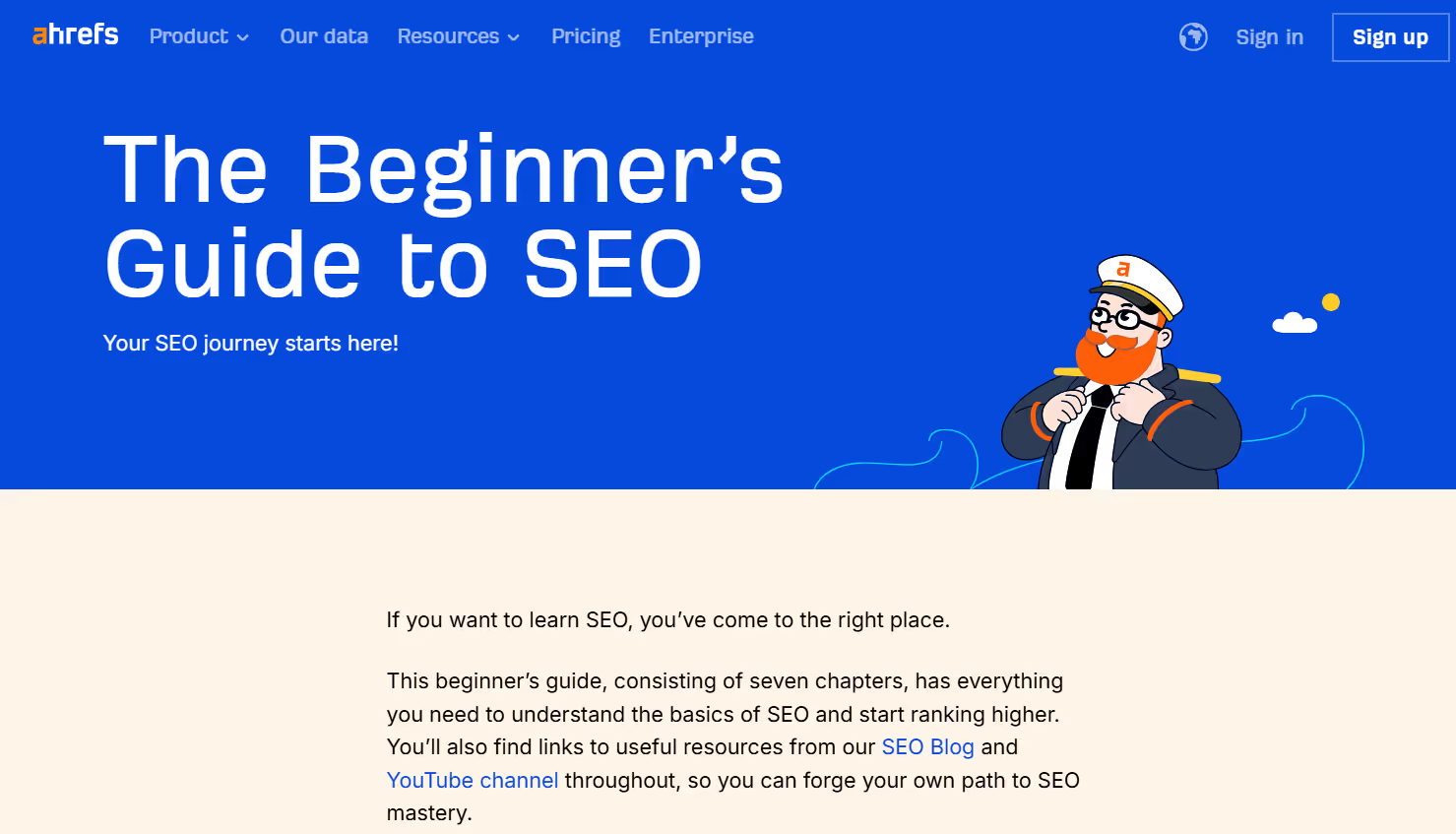
This format works because:
- It builds authority through structured, step-by-step content.
- It keeps readers engaged by solving real problems in each section.
- It becomes an evergreen resource teams can return to.
To create guides like this, break your topic into chapters, solve one problem at a time, and link to deeper resources. Think clarity, not complexity, and your readers will stick around longer.
3. Case Studies
78% of B2B marketers incorporate case studies and customer stories into their marketing campaigns, according to the Content Marketing Institute.
Case studies are one of the most powerful formats to showcase proof. They help potential buyers see how your solution performs in the real world, especially when they’re on the edge of a decision.
Take how we structured the Atlan case study at Revv Growth. What made the case study effective wasn’t just the outcome. It was how we unpacked the process:

- We started with the core search challenge Atlan faced
- Showed exactly how we optimized content for snippet capture
- Included visibility metrics and real search results
- And made the structure replicable for others targeting similar wins
A great case study is part success story, part how-to. When done right, it becomes a conversion asset your sales team will actually use.
4. White Papers
White papers are long-form reports built for depth. They’re often used when buyers need more than a blog; they need evidence, trends, and frameworks to justify a big decision.
Unlike guides, white papers are often research-backed and may be gated behind a form to capture leads.
Take Semrush’s State of Content Marketing report, for example. It dives deep into emerging industry trends using original research and survey data.
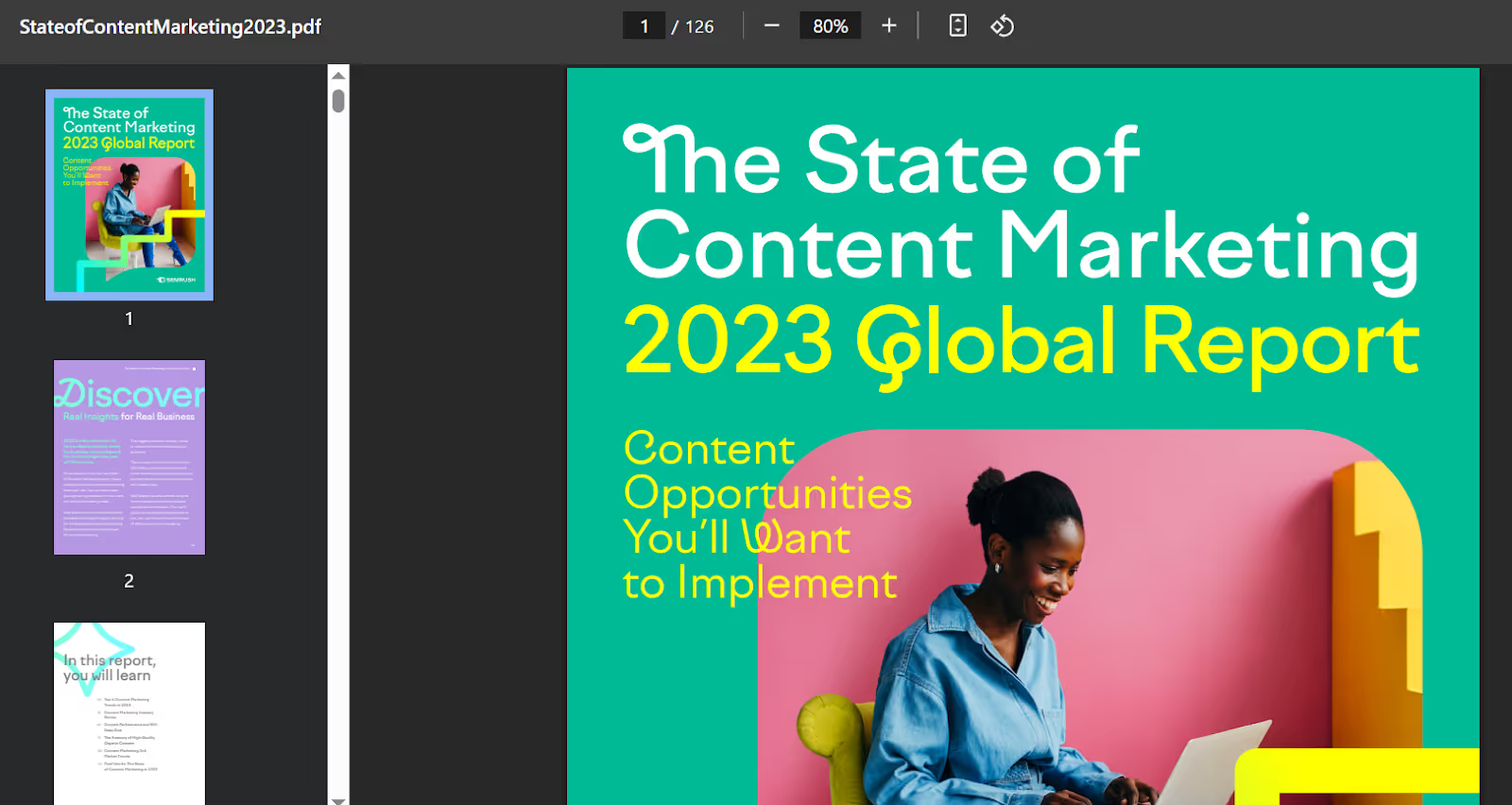
The content is segmented by use case and industry, making it easy for different audiences to find insights that apply to them.
What made it work?
- They focused on a timely shift in content marketing behavior
- Used proprietary data to add credibility
- Structured the content visually with graphs and key takeaways
- Avoided product pitches and kept the focus on market education
If you want your white paper to generate leads and not just sit in a folder, make sure it offers something new, not just recycled tips.
5. Newsletters
Newsletters are one of the simplest ways to stay top of mind with your B2B audience. Done right, they don’t just share updates, they build relationships, create trust, and spark conversations.
A great example is the newsletter written by Karthick, Call to Action. His emails are under 550 words, focus on one sharp insight from a real client or internal challenge, and end with a thought-provoking question instead of a sales pitch.
Readers reply, share it with teams, and often book calls without a hard CTA. It’s personal, story-led, and built for relevance.
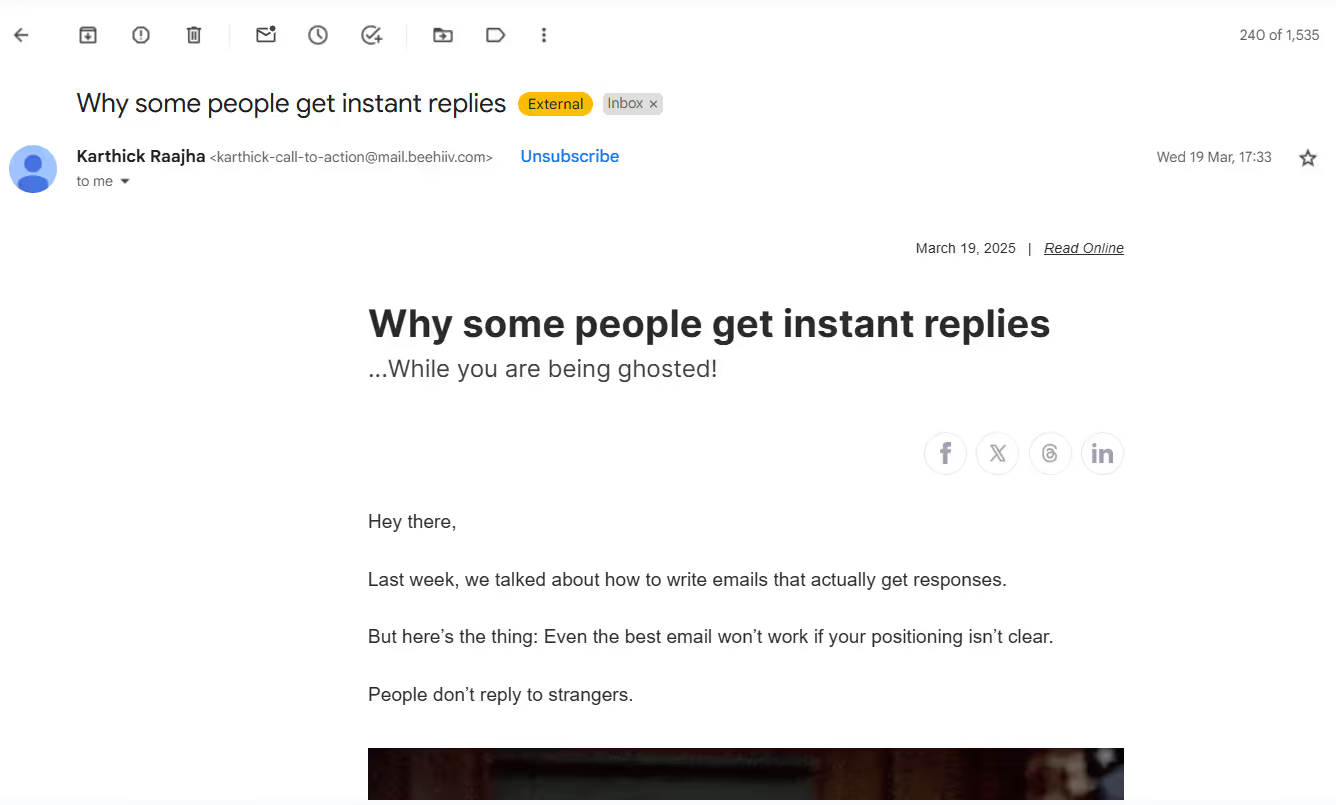
What made it effective?
- It addressed a real problem content teams face
- Told a short, first-person story to build trust
- Offered a takeaway without pitching
- Ended with a single, non-salesy CTA
Newsletters like this work because they create consistency, not noise. Whether you’re running nurture flows or founder-led campaigns, aim for clarity, usefulness, and just enough friction to spark a reply.
6. Email Sequences
Email sequences are a series of automated, timed emails sent to leads based on specific actions or intent signals like downloading a resource, engaging with a landing page, or visiting a product blog.
Unlike newsletters, which are one-time sends, sequences are built to nurture over time and guide B2B buyers from curiosity to conversion.
For Flipspaces USA, we created a 6-part email nurture sequence for leads who engaged with their office design ads.
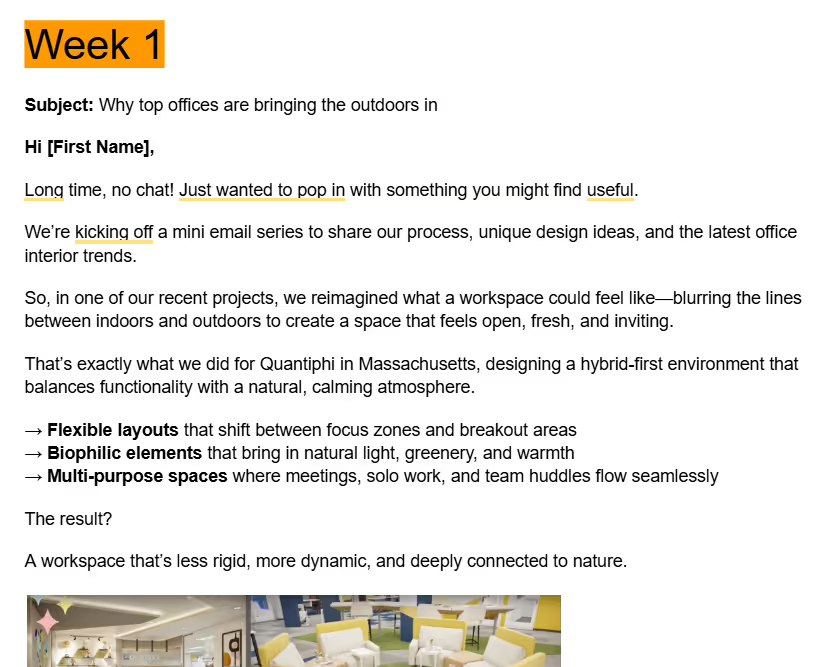
The flow started with a value-led intro email, followed by:
- A second email highlighting how Flipspaces transforms commercial/office spaces with immersive tech
- A third email featuring a case study to build credibility
- A final email that invited them to book a non-salesy design consult
Each email was conversational, under 200 words, and mapped to buyer interest, whether they were exploring or ready to engage.
7. Use Cases & Solutions Pages
Use case and solution pages explain how your product solves specific problems for specific audiences. Unlike feature pages, which often talk about what your product does, use case pages focus on outcomes, what your product helps people achieve.
These pages are critical for buyers who are evaluating fit. They want to know, “Is this actually built for a company like ours?”
Grammarly Business does this well. Instead of one generic page, they’ve created tailored use case pages for Sales, HR, and Customer Support teams.

Each page focuses on the team’s core challenge, like clarity in communication or reducing errors, and shows exactly how Grammarly helps them improve productivity. The structure is simple: define the problem, explain the outcome, and back it with proof.
8. Landing Pages
Landing pages are standalone pages built to convert interest into a specific action, booking a call, signing up for a demo, or downloading a resource. Unlike your homepage, they’re focused, goal-driven, and designed to match a buyer’s intent at the bottom of the funnel.
Our ABM agency landing page is built exactly for that. It starts with a direct, benefit-led headline: “Target Your Dream 100 Accounts Through Strategic ABM.” The copy speaks to what SaaS buyers at the decision stage care about, pipeline velocity, sales-marketing alignment, and execution support.

We kept the structure simple:
- Outcome-first headline that sets clear expectations
- Short, scannable sections highlighting the “why” behind our approach
- Proof through logos and testimonials
- One strong CTA, “Schedule a Call”, repeated at logical points
This page consistently converts high-intent traffic because it’s outcome-focused, skimmable, and written for buyers who already know what they need, just not who to trust yet.
9. Technical Documentation
Technical documentation is in-depth, how-to content designed to help users understand and implement your product, especially for developer tools, SaaS platforms, and data products.
Great docs make adoption easier and often influence purchase decisions for technical stakeholders. They’re also essential for onboarding and support.
Notion’s API documentation is a great example of how to do this well. It walks developers through authentication, endpoints, and integrations using clear, jargon-free language. Every section includes code examples, visual cues, and in-context links that guide users without overwhelming them.

Even in non-technical B2B services, sharing frameworks, workflows, or backend examples can serve a similar purpose. Documentation gives technical buyers and RevOps leaders confidence that what you’re offering won’t just work, it will work with them.
10. Social Media Content
Social is where your content meets your community. It’s not about polished branding, it’s about consistency, clarity, and conversation.
Eighty-five percent of B2B marketers say LinkedIn is the social media platform that delivers the best value for their organization.
In B2B, social is less about trends and more about trust. People follow people, not logos. So whether you’re posting as a brand or founder, the goal is to show up with value regularly.
Take Karthick Raajha, our founder at Revv Growth. When he posts on LinkedIn, it’s not to promote, it’s to reflect.

When he shares lessons from building the agency, navigating client challenges, or rethinking what "growth" really means, it sparks meaningful reactions. People engage not just because of the content but because they can feel there’s a real person behind it.
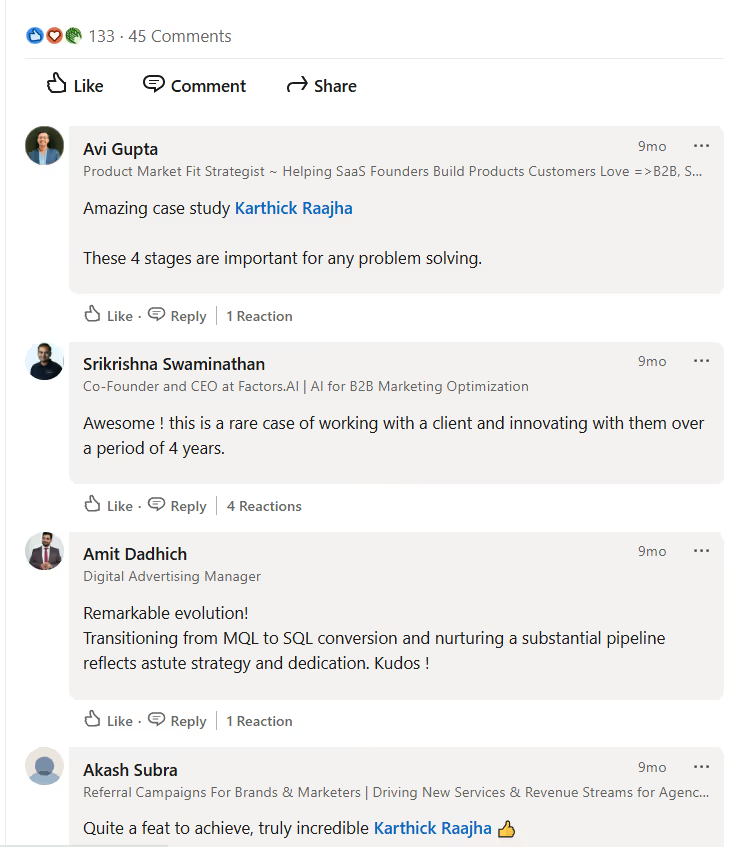
This kind of founder-led content doesn’t just earn likes, it starts sales conversations, attracts partners, and builds brand loyalty. If your brand is silent on social media, you’re invisible to the very people trying to decide if they can trust you.
Best Practices & Techniques to Write B2B Content in 2025
Writing B2B content that ranks isn’t enough. In 2025, your content needs to convert, get picked by AI summaries, and help sales close faster. Here’s how we write content that drives the pipeline.
1. Write for the Funnel, Not Just the Keyword
Effective B2B content aligns with where the reader is in their buying journey, like awareness, consideration, or decision, not just with search volume.
2. Structure for Scannability
Clear, logical formatting with headings, bullets, and short paragraphs makes it easier for busy B2B readers to get value quickly.
3. Keep It Clear and Conversational
Use human, jargon-free language that mirrors how your audience speaks. Clarity builds trust and drives action.
4. Use Real Stories, Not Hypotheticals
Buyers relate to real-world experiences more than theory. Stories improve memorability and make your content more persuasive.
5. Apply Frameworks That Guide the Reader
Using content frameworks like PAS (Pain, Agitation, Solution) and TEACH (Teach, Educate, Answer, Challenge, Help) brings clarity, flow, and intent to your writing.
6. Edit with Purpose
Every sentence should earn its place. Trim fluff, simplify structure, and optimize for clarity, tone, and readability.
7. Track Performance and Iterate
Publishing is step one. Analyze what’s working, update for search intent shifts, and turn winning content into a revenue-generating asset.
Final Thoughts
The best B2B content drives action, not just rankings. It speaks directly to decision-makers, addressing their pain points, challenges, and needs. It’s built on trust, thought leadership, and strategic storytelling, not keyword stuffing or lead-gen gimmicks.
From building outlines rooted in search intent and sales conversations to optimizing for featured snippets and internal linking to tracking what actually matters (like conversion rate and pipeline impact), you now have a clear blueprint on how to create B2B content that informs, engages, and converts.
At Revv Growth, we don’t just help you rank, we help you close. Whether you need high-converting bottom-of-funnel content, SEO-optimized blog hubs, or strategic messaging aligned with your GTM motion, our team knows how to create content that turns traffic into trust and trust into revenue.
So, if you’re ready to move beyond basic blogs and build a B2B content engine that drives real growth, let’s talk.
Book a content strategy call with us, and let’s turn your expertise into content that converts.



.svg)
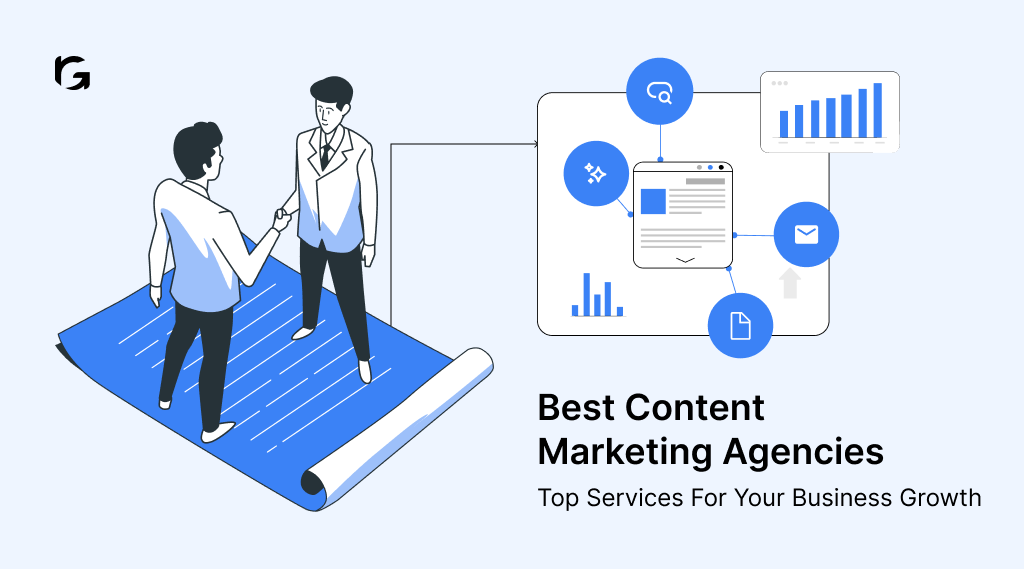
.png)
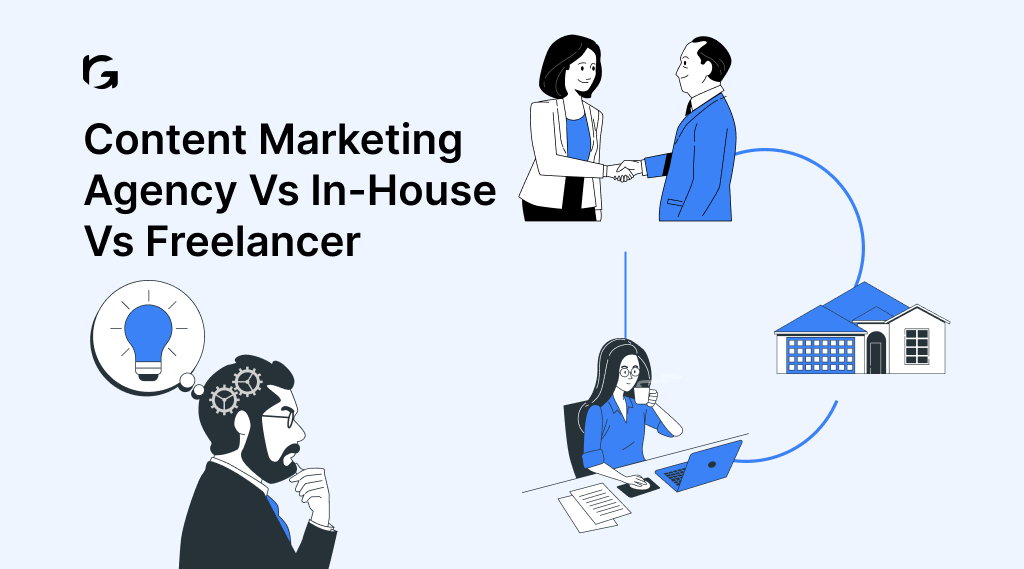
.webp)